A Century of Great Songs: E. L. Jorgenson’s Remarkable Hymnal
Introduction
The story begins in rural Nebraska, hardly a stronghold of the Restoration Movement, with Danish immigrants Christopher and Lena Jorgenson. Despite their limited capacity with the English language they enthusiastically embraced the reform plea of the Churches of Christ. Their son Elmer Leon Jorgenson (1886-1968) employed his great musical ability and Christian devotion to compile the most enduring hymnal used among Churches of Christ and Christian Churches. Great Songs of the Church, ten years in the making, debuted in May 1921. Seventy years and millions of copies later it was still in print–surpassing the astonishing sixty-year print run of Alexander Campbell’s hymnal. Advertised as the ‘Golden Book of Sacred Song,’ and affectionately known as ‘Old Blue,’ Great Songs of the Church was used by congregations, schools, colleges and universities, and singing assemblies around the world.
Great Songs of the Church. A Comprehensive Collection of Psalms, Hymns, and Spiritual Songs of First Rank, Suitable for all Services of the Church. Alphabetically Arranged. E. L. Jorgenson, Compiler. First edition. Word and Work: Louisville, 1921. Green cover with round notes. Right, 1935 printing of the second edition with shaped notes, red cover.

Great Songs of the Church. A Comprehensive Collection of Psalms, Hymns, and Spiritual Songs of First Rank, Suitable for all Services of the Church. Alphabetically Arranged. E. L. Jorgenson, Compiler. First edition. Word and Work: Louisville, 1921. Green cover with round notes. Front cover.
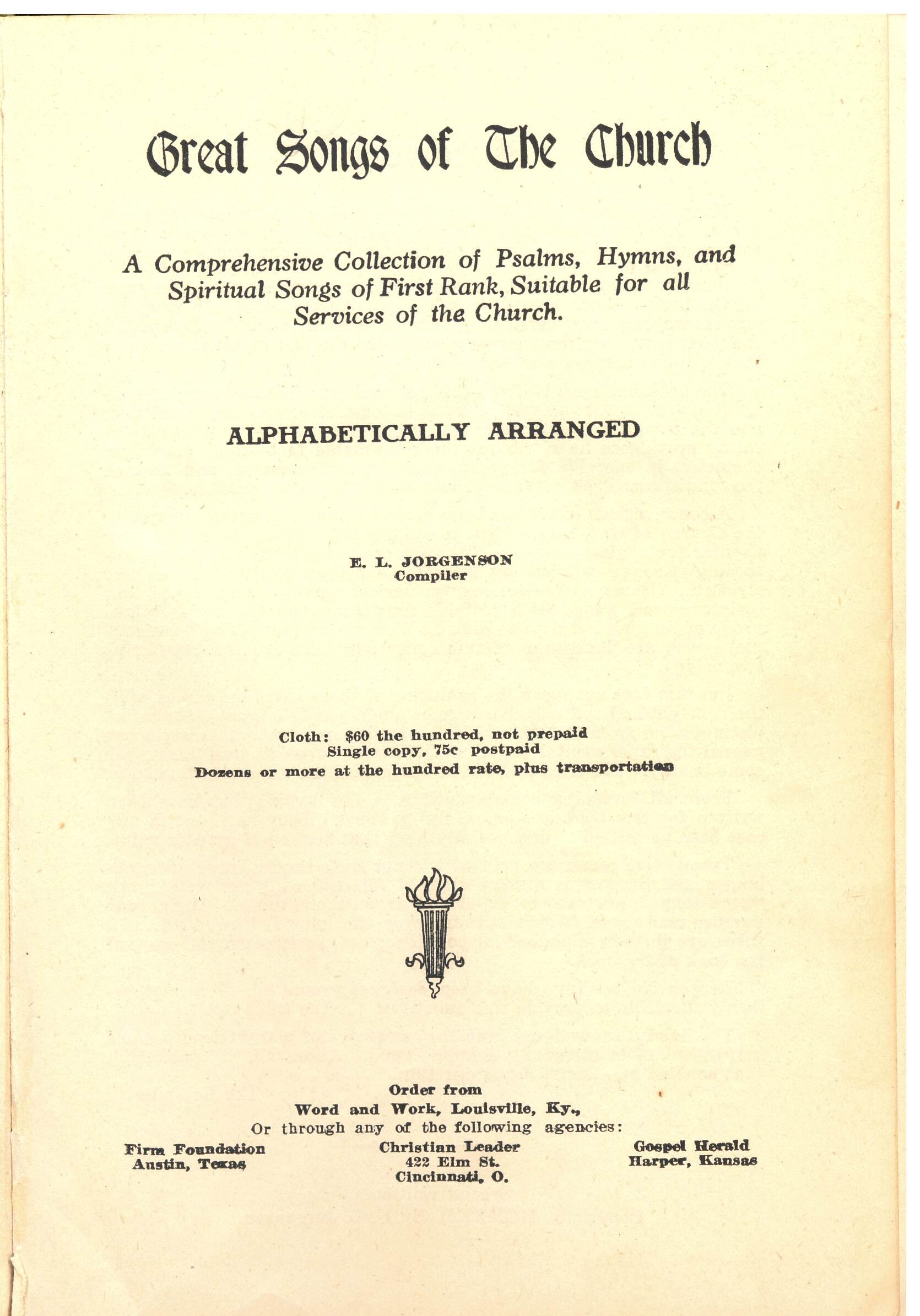
Great Songs of the Church. A Comprehensive Collection of Psalms, Hymns, and Spiritual Songs of First Rank, Suitable for all Services of the Church. Alphabetically Arranged. E. L. Jorgenson, Compiler. First edition. Word and Work: Louisville, 1921. Green cover with round notes. Title page.
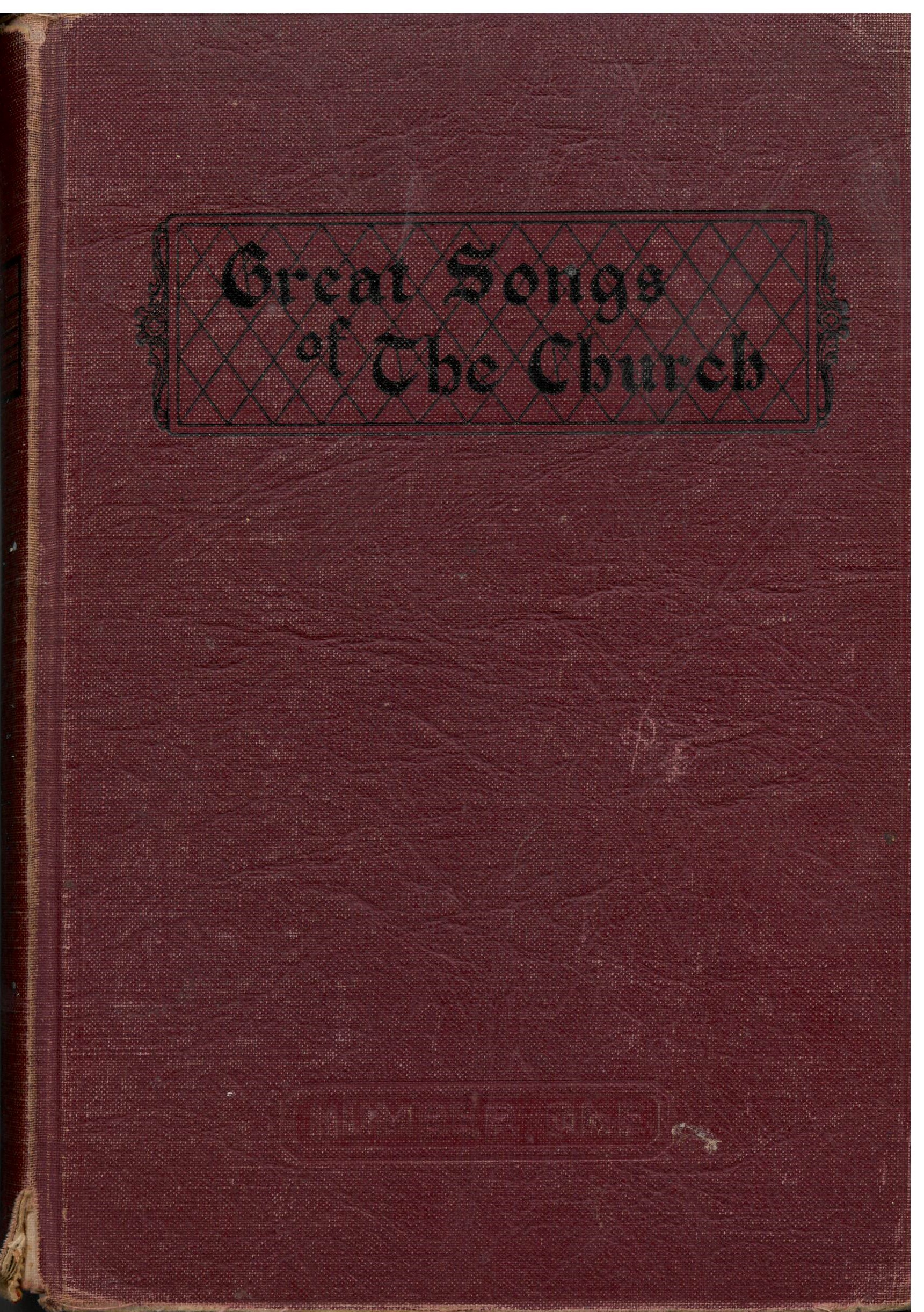
Great Songs of the Church. A Comprehensive Collection of Psalms, Hymns, and Spiritual Songs of First Rank, Suitable for all Services of the Church. Alphabetically Arranged. E. L. Jorgenson, Compiler. First edition. Great Songs Press: Louisville, 1935 printing, red cover with round notes. Front cover.
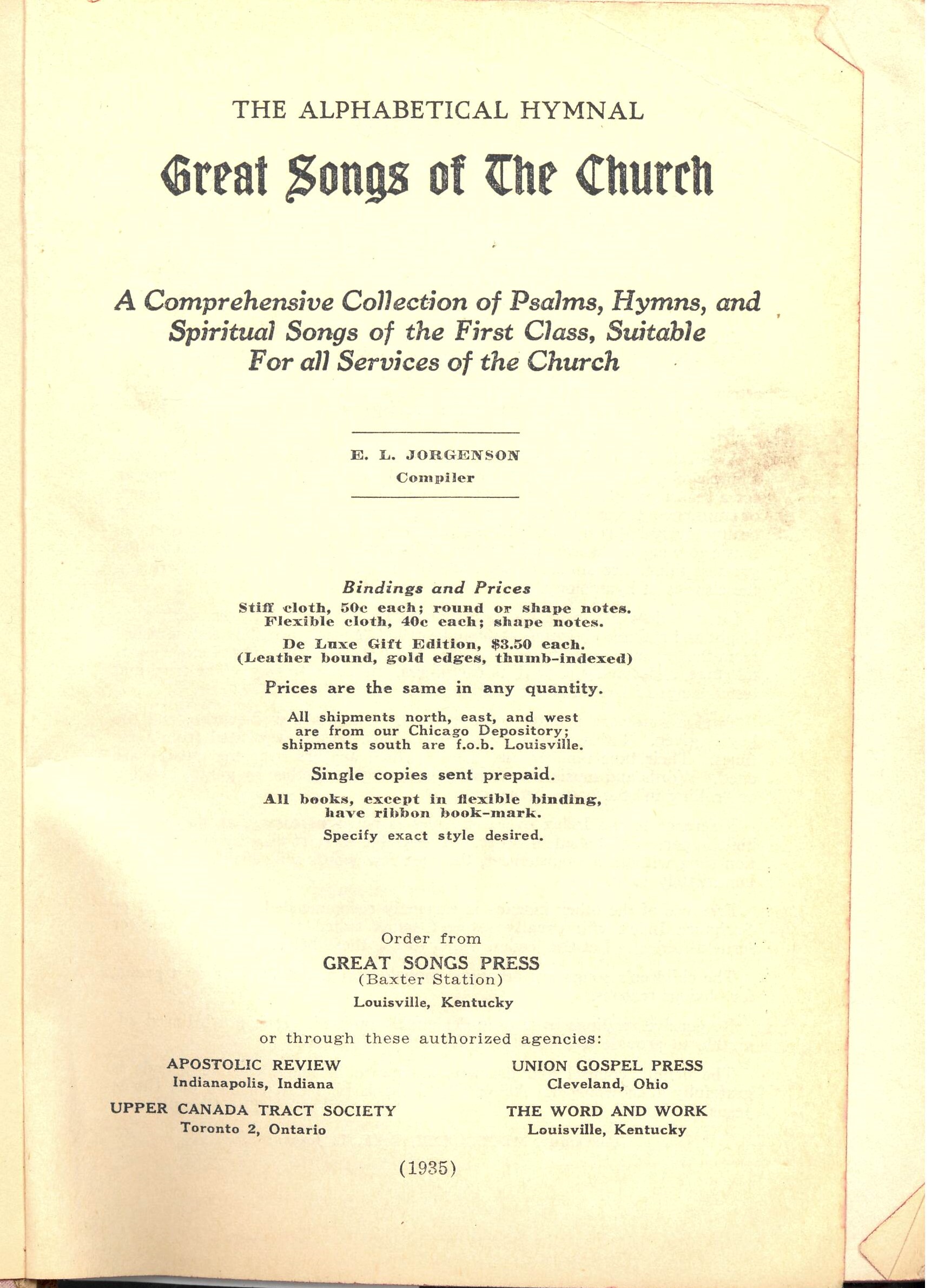
Great Songs of the Church. A Comprehensive Collection of Psalms, Hymns, and Spiritual Songs of First Rank, Suitable for all Services of the Church. Alphabetically Arranged. E. L. Jorgenson, Compiler. First edition. Great Songs Press: Louisville, 1935 printing, red cover with round notes. Title page.
The New Alphabetical Hymnal. Great Songs of the Church Number Two. A Treasury of Six Hundred Sacred Songs Suitable for All Services of the Church. E. L. Jorgenson, Compiler. Great Songs Press: Louisville, 1937.
With this major revision Jorgenson built upon the Great Songs tradition by adding many songs and expanding the reach of the round note edition. In 1940 Standard Publishing Company (Cincinnati, Ohio) began widely marketing the round note edition among Christian Churches. This joint venture reflected Jorgenson’s devotion to unity within the Restoration Movement and opened a door for that edition (which also included responsive readings) to be used by several Protestant groups over the next two decades.
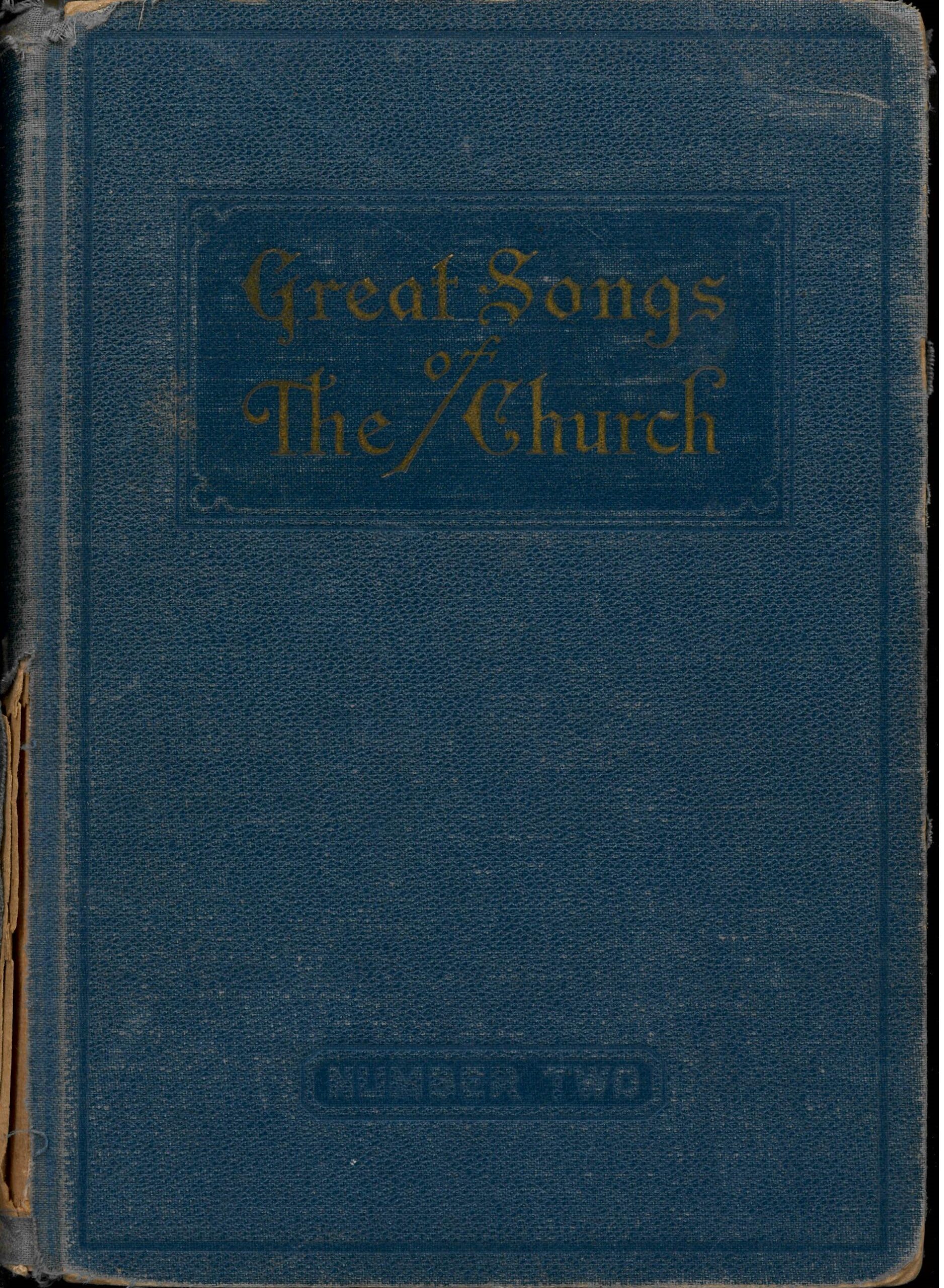
The New Alphabetical Hymnal. Great Songs of the Church Number Two. A Treasury of Six Hundred Sacred Songs Suitable for All Services of the Church. E. L. Jorgenson, Compiler. Great Songs Press: Louisville, 1937. Front cover.

The New Alphabetical Hymnal. Great Songs of the Church Number Two. A Treasury of Six Hundred Sacred Songs Suitable for All Services of the Church. E. L. Jorgenson, Compiler. Great Songs Press: Louisville, 1937. Title page.
Light blue cover with round notes (pictured above) is a first printing (1937) of ‘Number Two.’ The red cloth continued to be used for the shaped note editions throughout the 1940s. The dark blue printing (1952, below) is one of the last editions issued under Jorgenson’s ownership. The baby blue edition (1976) was apparently due to shortage of dark blue cloth at the bindery. The deluxe red leather edition, with gold page edges, was a favorite choice of song leaders.

The New Alphabetical Hymnal. Great Songs of the Church Number Two. A Treasury of Six Hundred Sacred Songs Suitable for All Services of the Church. E. L. Jorgenson, Compiler. Great Songs Press: Louisville, 1952. Front cover.

The New Alphabetical Hymnal. Great Songs of the Church Number Two. A Treasury of Six Hundred Sacred Songs Suitable for All Services of the Church. E. L. Jorgenson, Compiler. Great Songs Press: Louisville, 1952. Title page.

The New Alphabetical Hymnal. Great Songs of the Church Number Two. A Treasury of Six Hundred Sacred Songs Suitable for All Services of the Church. E. L. Jorgenson, Compiler. Great Songs Press: Hammond, Louisiana, 1976. Front cover.
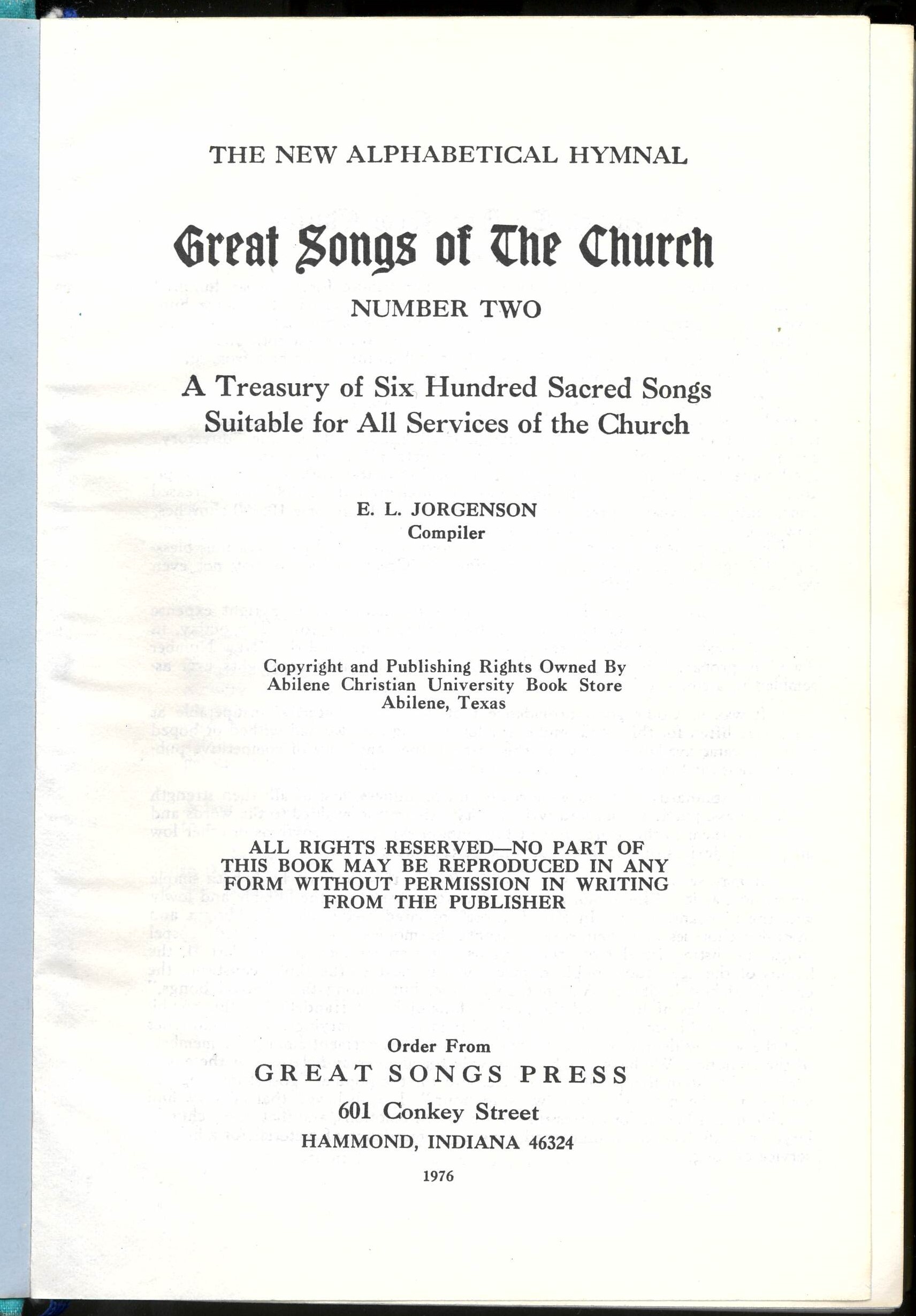
The New Alphabetical Hymnal. Great Songs of the Church Number Two. A Treasury of Six Hundred Sacred Songs Suitable for All Services of the Church. E. L. Jorgenson, Compiler. Great Songs Press: Hammond, Louisiana, 1976. Title page.
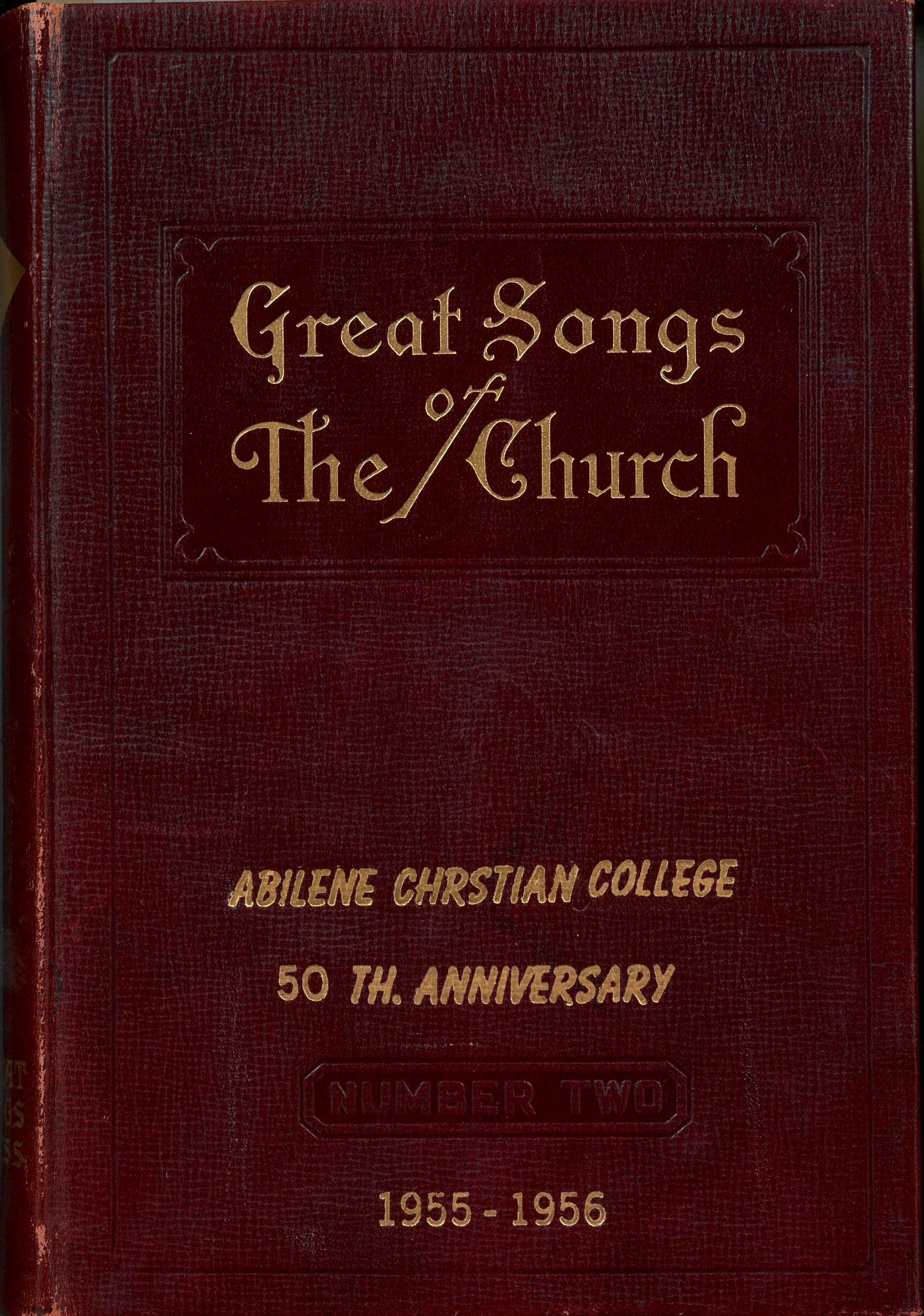
The New Alphabetical Hymnal. Great Songs of the Church Number Two. A Treasury of Six Hundred Sacred Songs Suitable for All Services of the Church. Great Songs Press: Chicago, 1955. Front cover.

The New Alphabetical Hymnal. Great Songs of the Church Number Two. A Treasury of Six Hundred Sacred Songs Suitable for All Services of the Church. Great Songs Press: Chicago, 1955. Title page.
The Formation of Great Songs of the Church, 1900-1920
The Jorgenson’s were devout Danish Lutherans who were compelled by the love they experienced at the Church of Christ in Boone County, Nebraska when Elmer was a boy. They were also musically talented and steeped in the hymnic tradition of the Protestant Reformation. As teen Elmer, center, served as ‘Song Evangelist’ for preaching tours such as the one described in this poster. These tours deepened his convictions about the formative power of song and the need for improved hymnody among Churches of Christ. After a short stint teaching music at Western Bible and Literary College in Odessa, Missouri, he moved to Louisville, Kentucky in 1910 where he spent a decade sifting tens of thousands of songs from across Christian hymnody to compile Great Songs. His co-workers in this 1906 tour, Claud Francis Witty and William John Campbell, and the faculty and most patrons of the Odessa school, and his associates in Louisville were all committed to acapella music in Christian worship. Elmer shared this conviction and contributed his time, talent, and resources to improve the quality of congregational singing, the teaching it reflected, and the devotion it inspired.
Poster. September 1906. On loan from M. Ice, Director of Special Collections

Poster. September 1906. On loan from M. Ice, Director of Special Collections
Alexander Campbell believed a united people should share a common hymn book which accurately reflected Biblical teaching. His book was the most widely used among Restoration congregations in his lifetime and remained in print for just over twenty years following his death.
Jorgenson followed Campbell’s lead and attempted to fulfill J. W. McGarvey’s wish for a single hymnal that combined the best selections from all books. He drew inspiration from some of the more popular hymnals used among Restoration congregations in the post-Campbell years. The New Christian Hymn and Tune Book included many examples of the emerging ‘gospel song’ genre while W. E. M. Hackleman, on the other hand, attempted to elevate Disciple hymnody with a wide selection of stately hymns. Jorgenson aimed to compile a book with the breadth of use enjoyed by Campbell, which joined the best popular gospel songs to the stateliest hymns from the broad Christian tradition. He published his results on May 16, 1921 under the title Great Songs of the Church.
The Christian Hymn Book: A Compilation of Psalms, Hymns and Spiritual Songs, Original and Selected. 5th ed. Printed and Published by A. Campbell: Bethany, 1860.
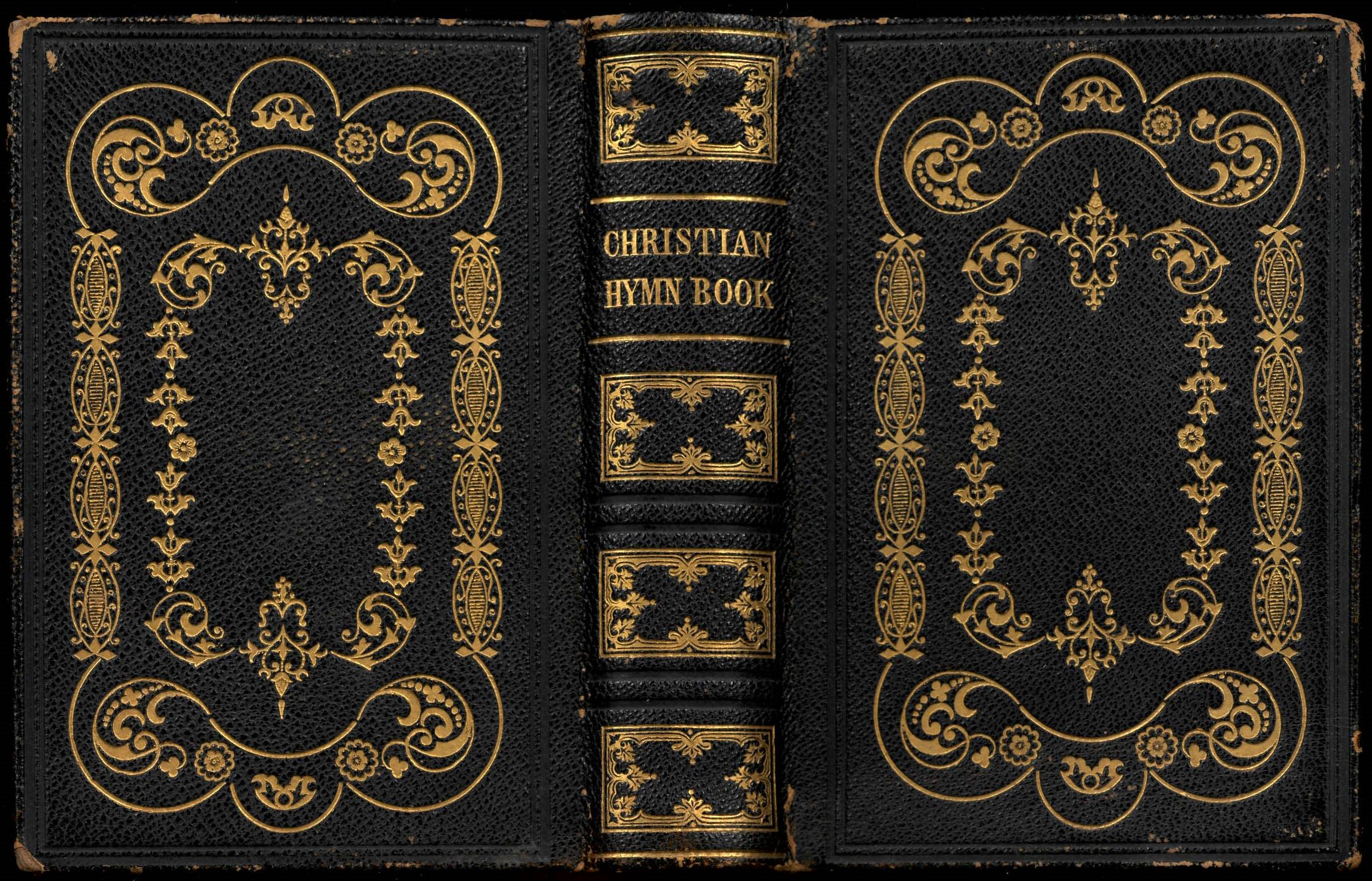
The Christian Hymn Book: A Compilation of Psalms, Hymns and Spiritual Songs, Original and Selected. 5th ed. Printed and Published by A. Campbell: Bethany, 1860. Covers.
The New Christian Hymn and Tune Book: A Selection of Hymns and Tunes for Christian Worship. Fillmore Music House: Cincinnati, 1887.
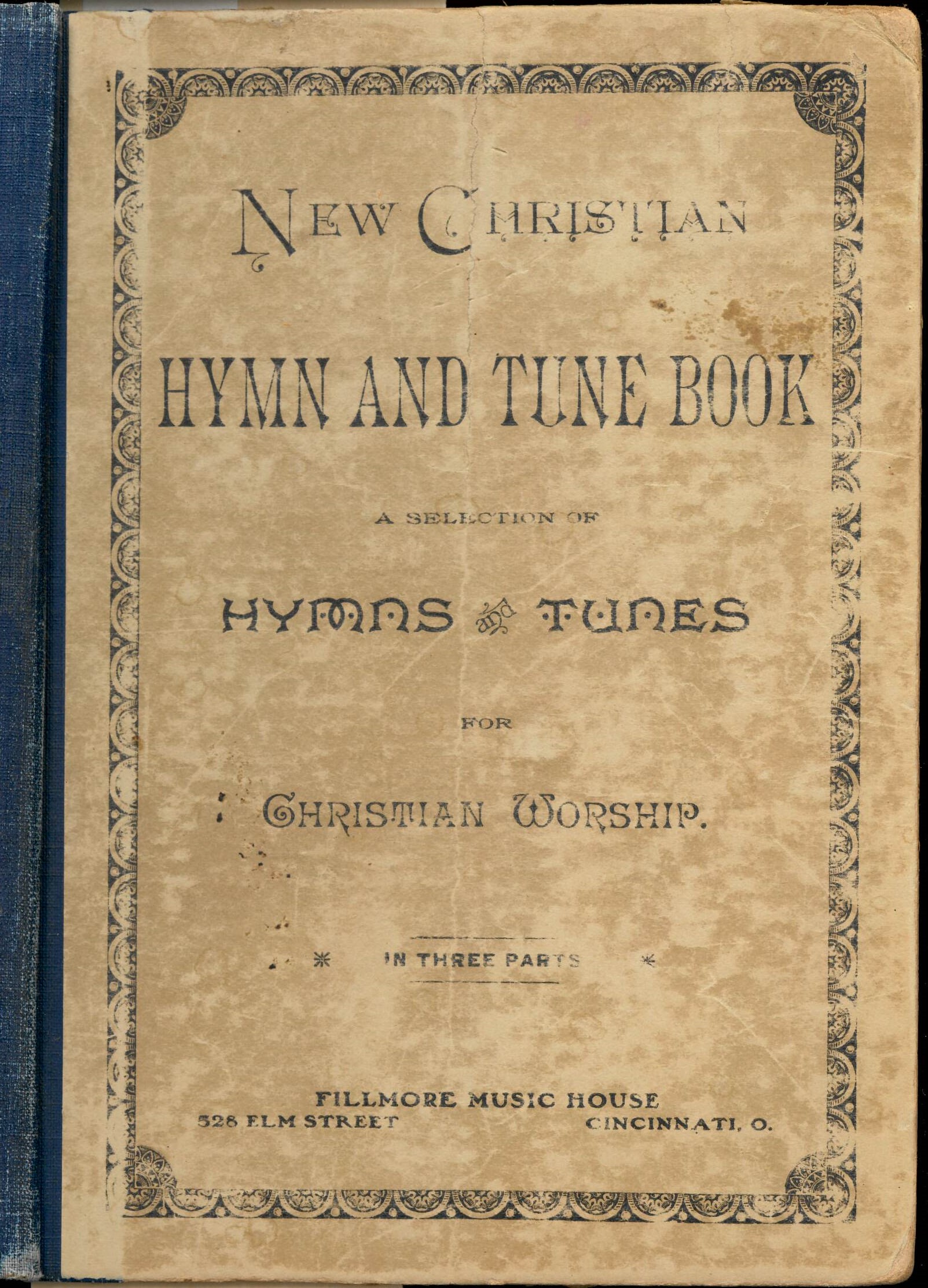
The New Christian Hymn and Tune Book: A Selection of Hymns and Tunes for Christian Worship. Fillmore Music House: Cincinnati, 1887. Front cover.
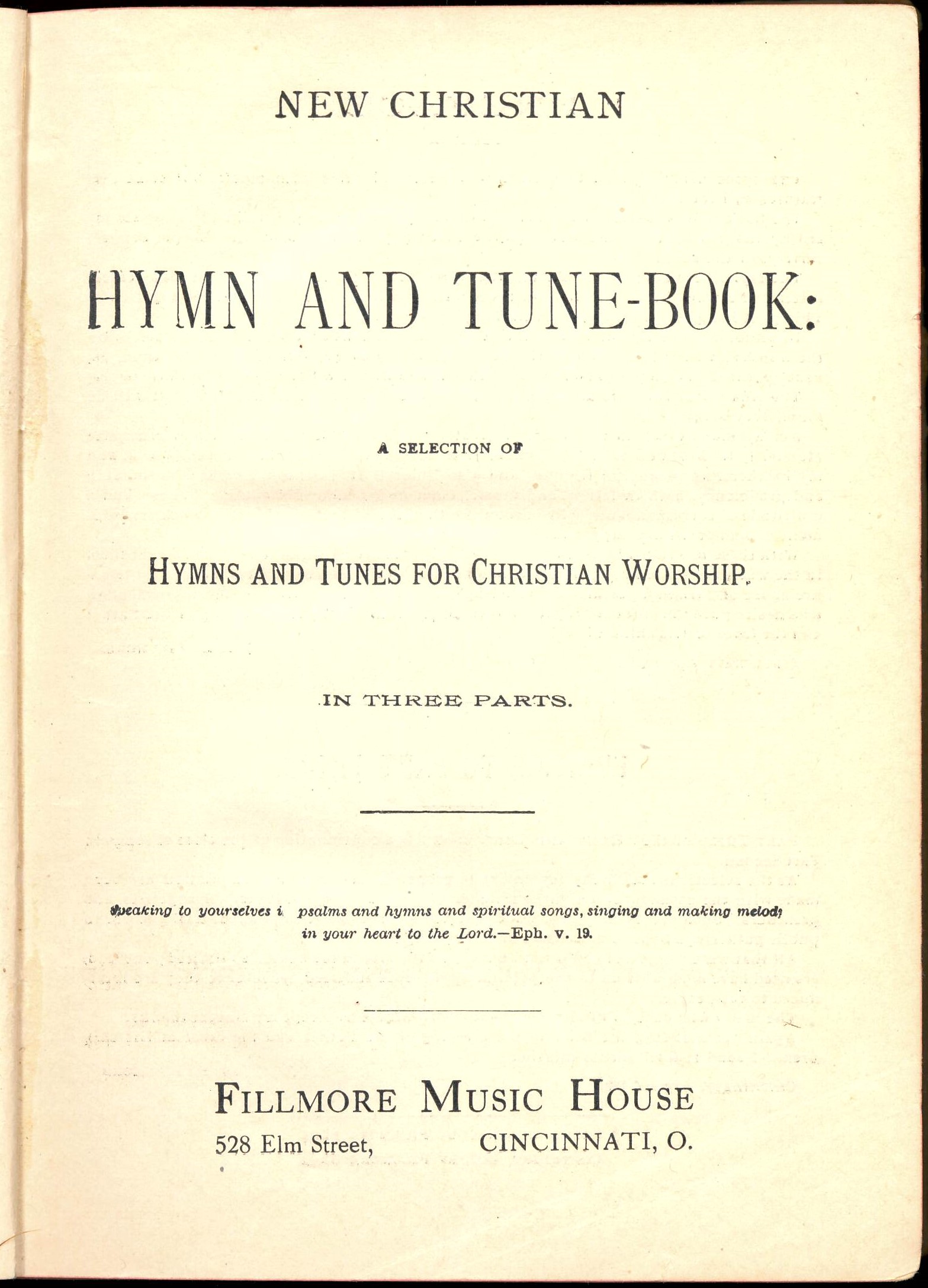
The New Christian Hymn and Tune Book: A Selection of Hymns and Tunes for Christian Worship. Fillmore Music House: Cincinnati, 1887. Title page.
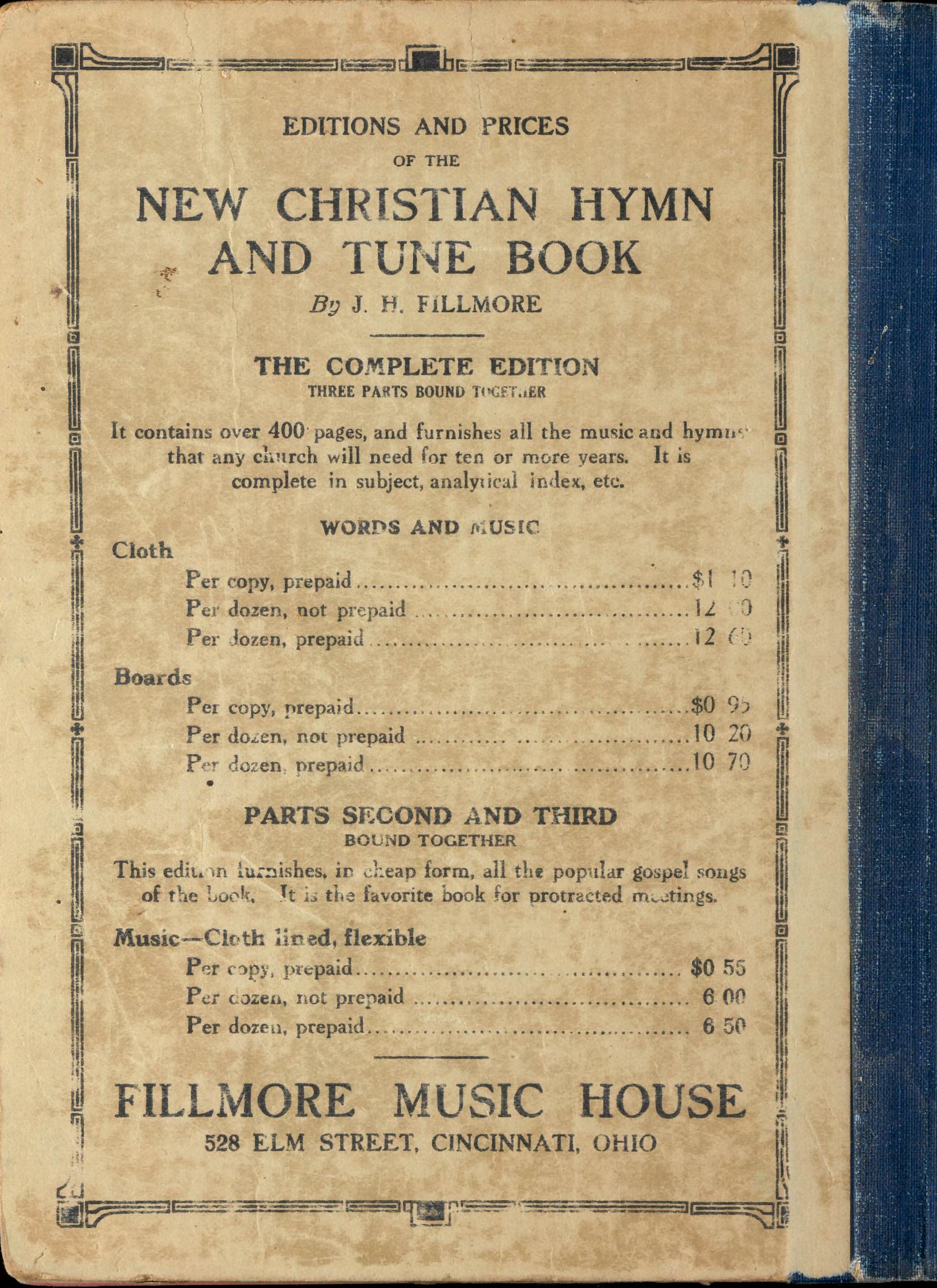
The New Christian Hymn and Tune Book: A Selection of Hymns and Tunes for Christian Worship. Fillmore Music House: Cincinnati, 1887. Rear cover.
Gloria in Excelsis, A Collection of Responsive Scripture Readings, Standard Hymns and Tunes, and Spiritual Songs for Worship in the Church and Home. William E. M. Hackleman, Compiler. Hackleman Music Company: Indianapolis and Christian Board of Publication: St. Louis, 1905.
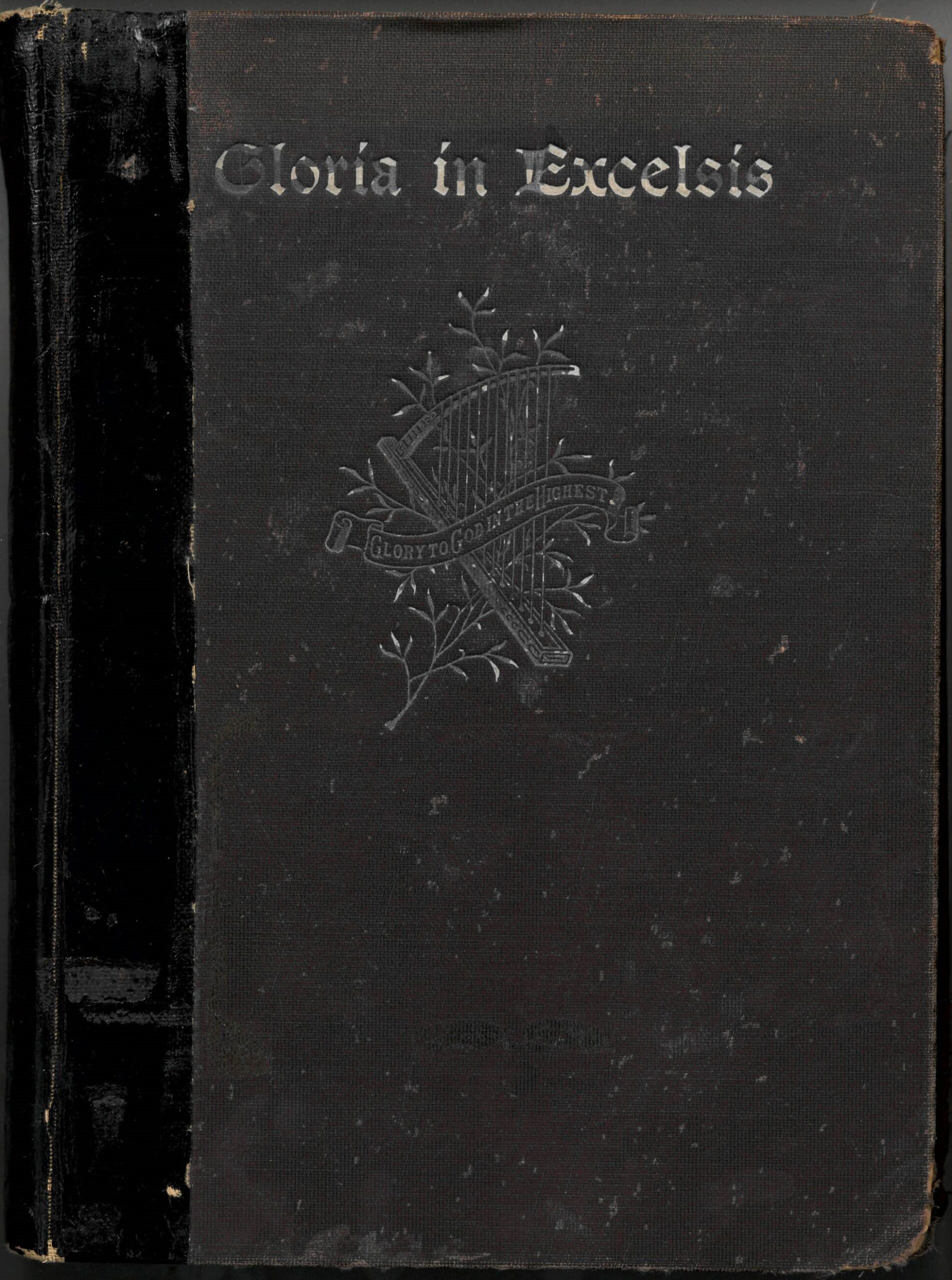
Gloria in Excelsis, A Collection of Responsive Scripture Readings, Standard Hymns and Tunes, and Spiritual Songs for Worship in the Church and Home. William E. M. Hackleman, Compiler. Hackleman Music Company: Indianapolis and Christian Board of Publication: St. Louis, 1905. Front cover.
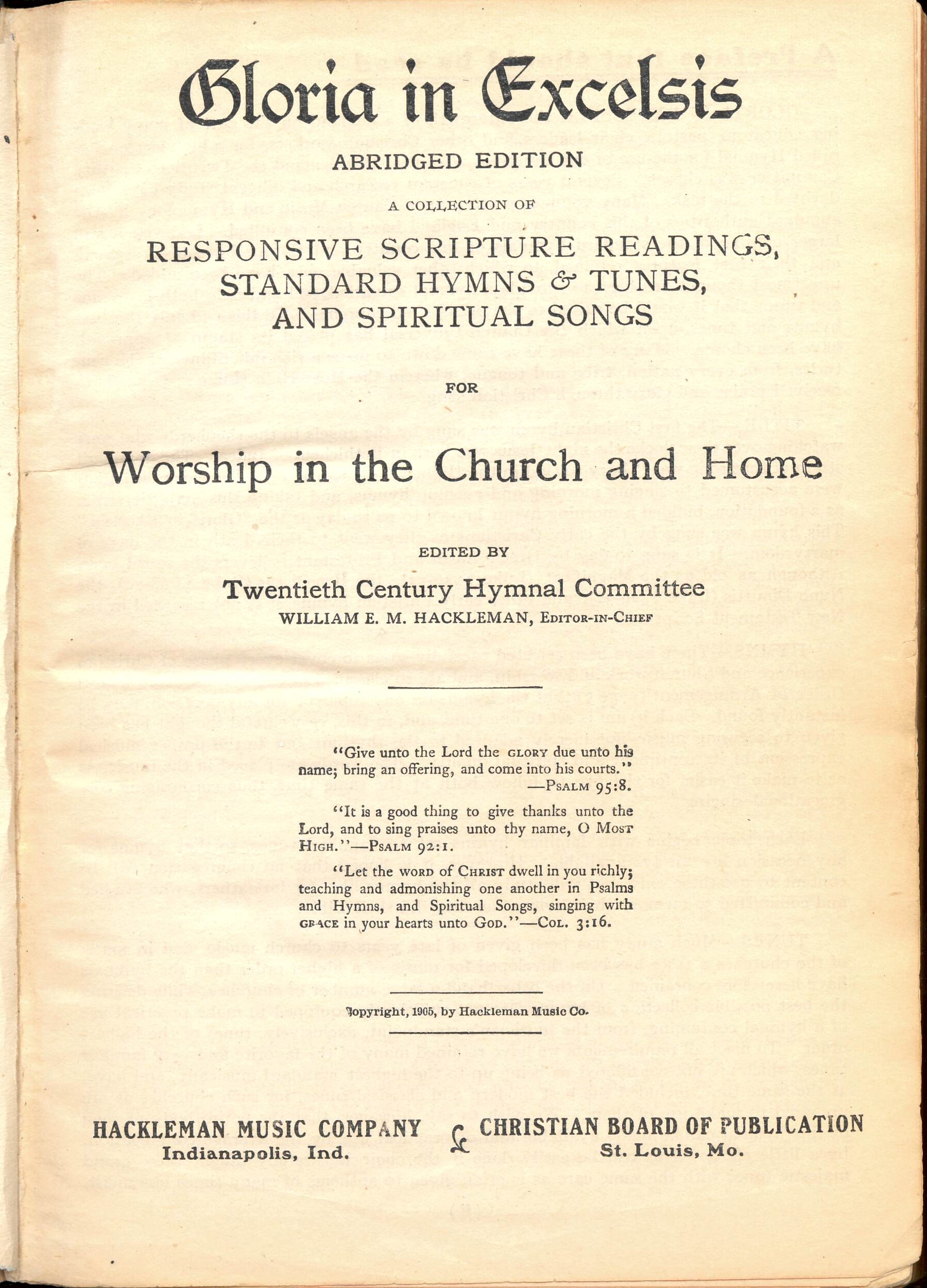
Gloria in Excelsis, A Collection of Responsive Scripture Readings, Standard Hymns and Tunes, and Spiritual Songs for Worship in the Church and Home. William E. M. Hackleman, Compiler. Hackleman Music Company: Indianapolis and Christian Board of Publication: St. Louis, 1905. Title page.
Hymni Ecclesiae, or Hymns of the Church. W. E. M. Hackleman and E. O. Excell, Compilers. Hackleman Music Company: Indianapolis, 1911.

Hymni Ecclesiae, or Hymns of the Church. W. E. M. Hackleman and E. O. Excell, Compilers. Hackleman Music Company: Indianapolis, 1911. Front cover. ACU copy lacks the title page.
Photograph, Elmer Leon Jorgenson. 1930.
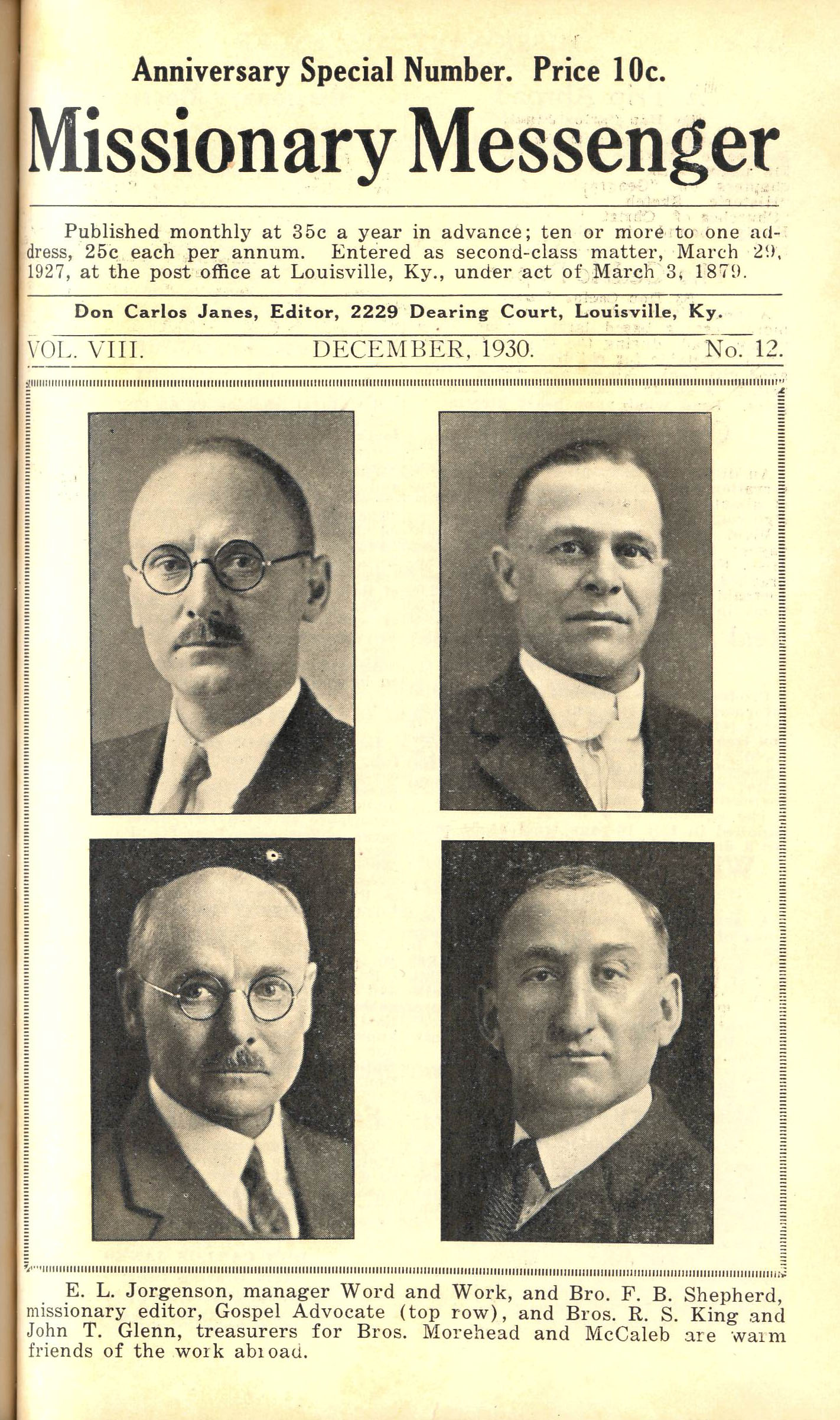
Missionary Messenger, December 1930, photographs of E. L. Jorgenson, F. B. Shepherd, John T. Glenn, and R. S. King.

Missionary Messenger, December 1930, detail photograph of E. L. Jorgenson
Great Songs in the 1920s-1940s: A breakthrough achievement and a compiler’s dreams come true
Jorgenson’s organizing principle was simple: “No song can enter there unless it is indispensable, or at least so very excellent, so scriptural, so beautiful, so useful in saving sinners, or in edifying saints, so true and tried…that if we knew the song, we simply would not want to do without it.”
However, he soon faced a seemingly insurmountable challenge. Since some hymnal compilers were also composers, they paired their compositions to a few select copyrighted songs then filled the remainder of their books with popular public domain material. But competition stiffened and hymnals grew in size as publishers amassed larger copyright holdings. They escalated rivalries by refusing to allow their holdings to appear in a competitor’s book. Edwin Othello Excell (who owned E. O. Excell Publishing Company), Homer Rodeheaver (and Rody-Tabernacle Publishing Company), Charles Alexander, and Hope Publishing Company (which acquired Bigelow and Main Company) all competed fiercely for market share among hymnal compilers in the early 20th century. Jorgenson went to Chicago to negotiate with Excell but was pick-pocketed just before the meeting. Excell welcomed him into his home for a few days while they sorted out the recovery of his identification and funds. This broke the ice and he relented, allowing Jorgenson to use any of his songs along with those of any other publisher. Other publishers followed suit and for the first time in modern Protestant hymnody the works of competing copyright holders appeared together in the same book. This 1930 printing of Great Songs opened to #422 and #423 illustrates how providence, a pick-pocket, and E. L. Jorgenson made the impossible commonplace.
Photographs. E. O. Excell and Charles M. Alexander from George C. Stebbins: Reminiscences and Gospel Hymn Stories. George H. Doran Company: New York, 1924.
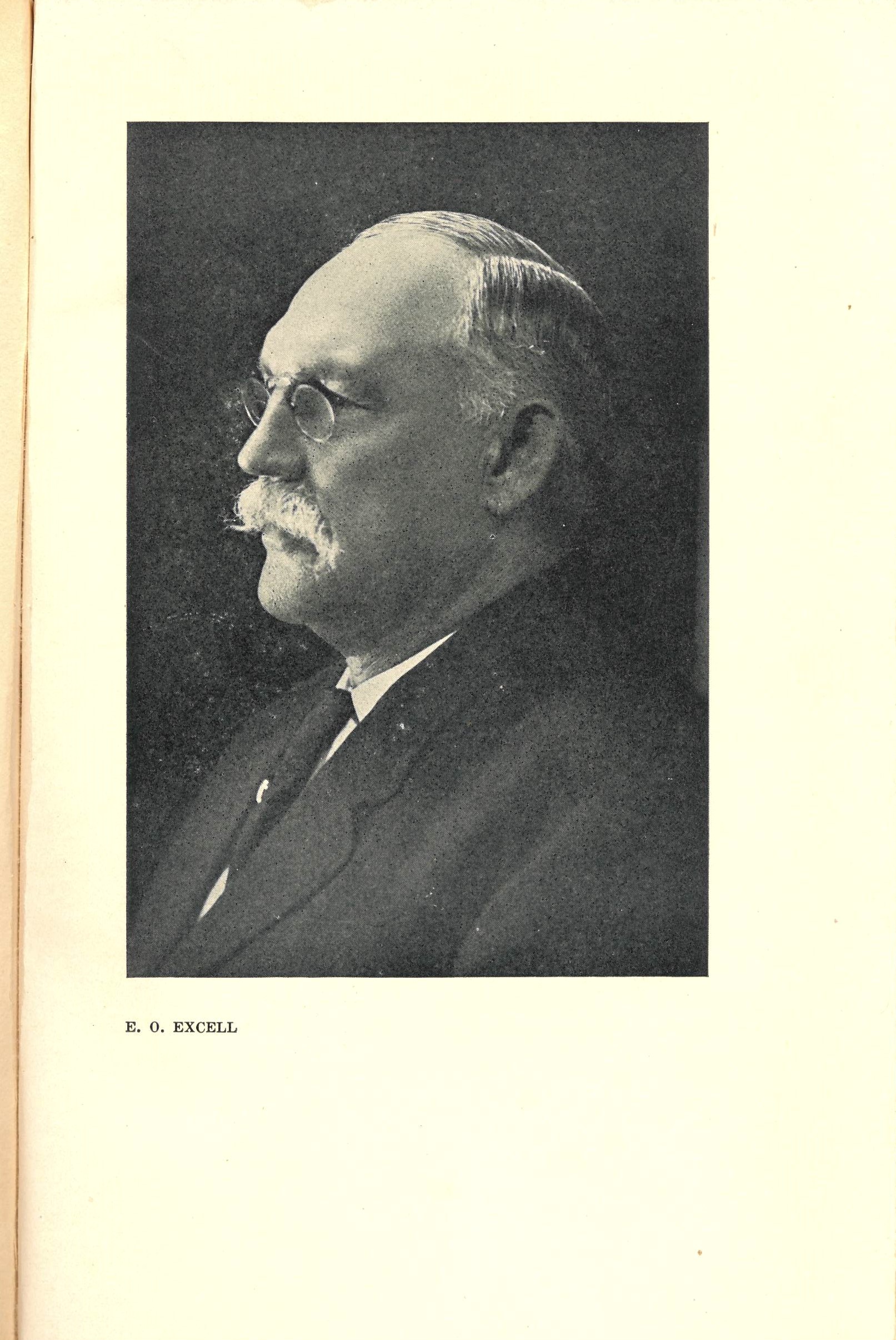
Photograph. E. O. Excell, from George C. Stebbins: Reminiscences and Gospel Hymn Stories. George H. Doran Company: New York, 1924.
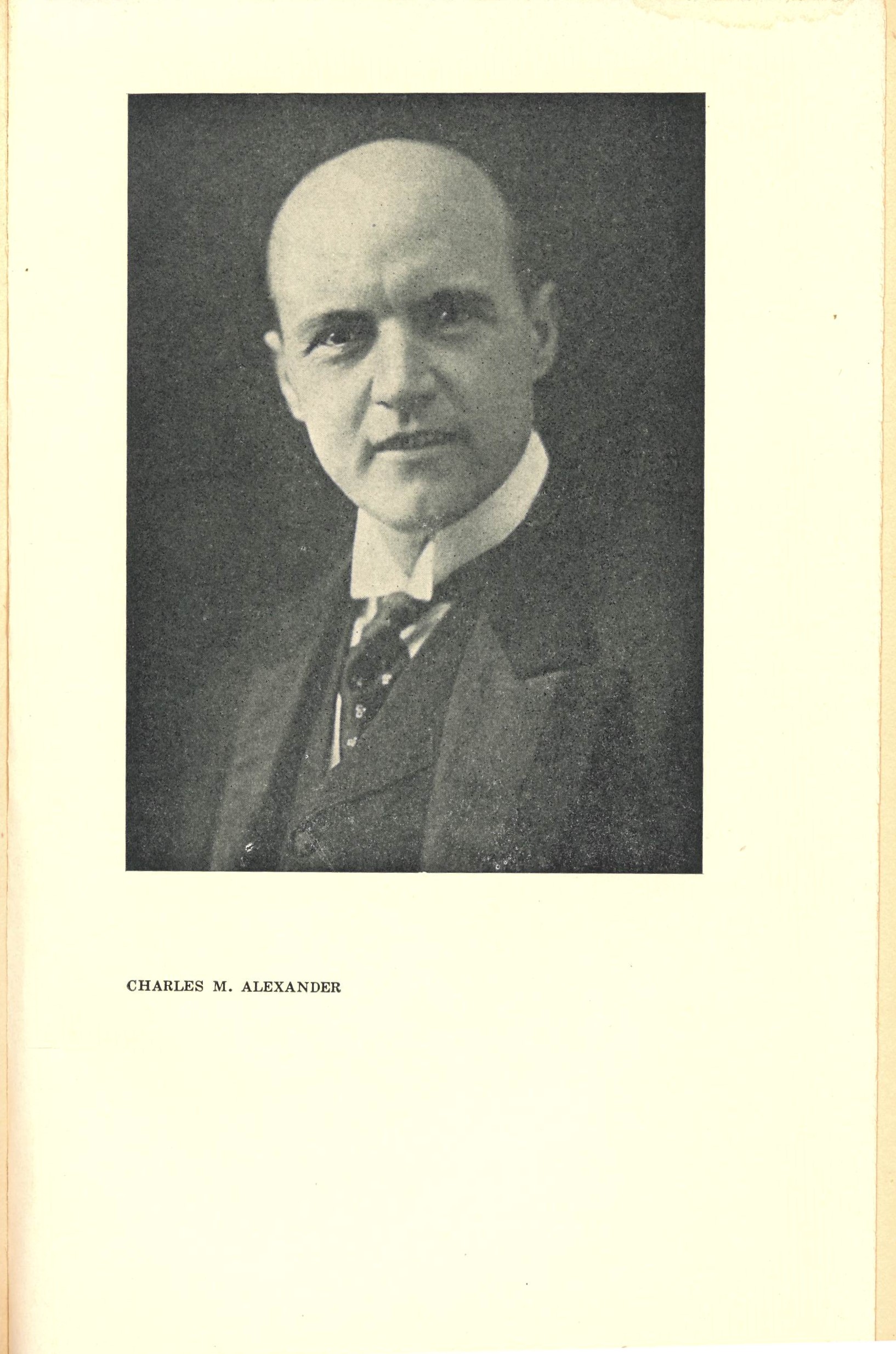
Photograph. Charles M. Alexander, from George C. Stebbins: Reminiscences and Gospel Hymn Stories. George H. Doran Company: New York, 1924.
Hymns and Sacred Songs. E. O. Excell, Editor. Hope Publishing Company: Chicago,1918.
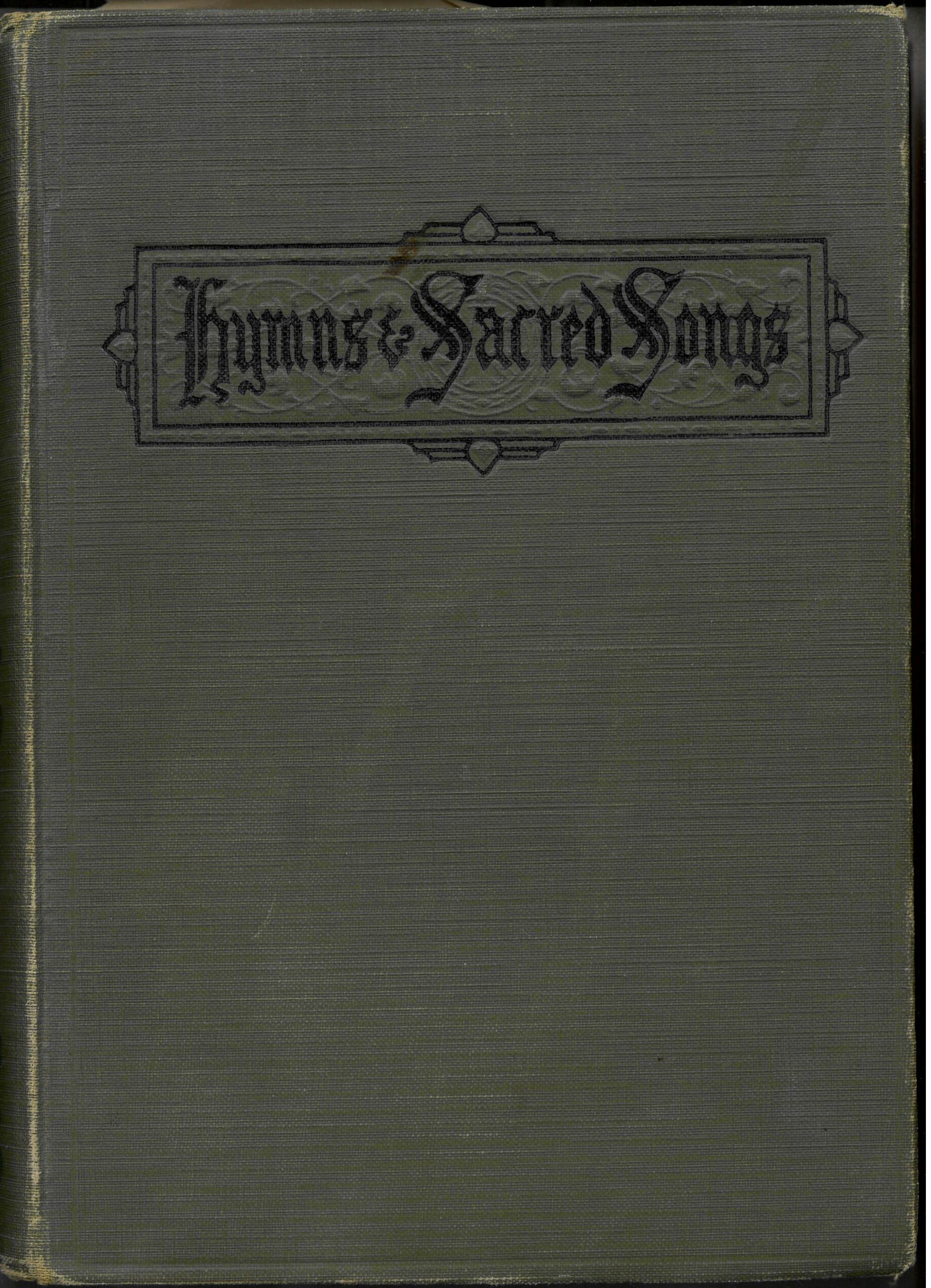
Hymns and Sacred Songs. E. O. Excell, Editor. Hope Publishing Company: Chicago,1918. Front cover.
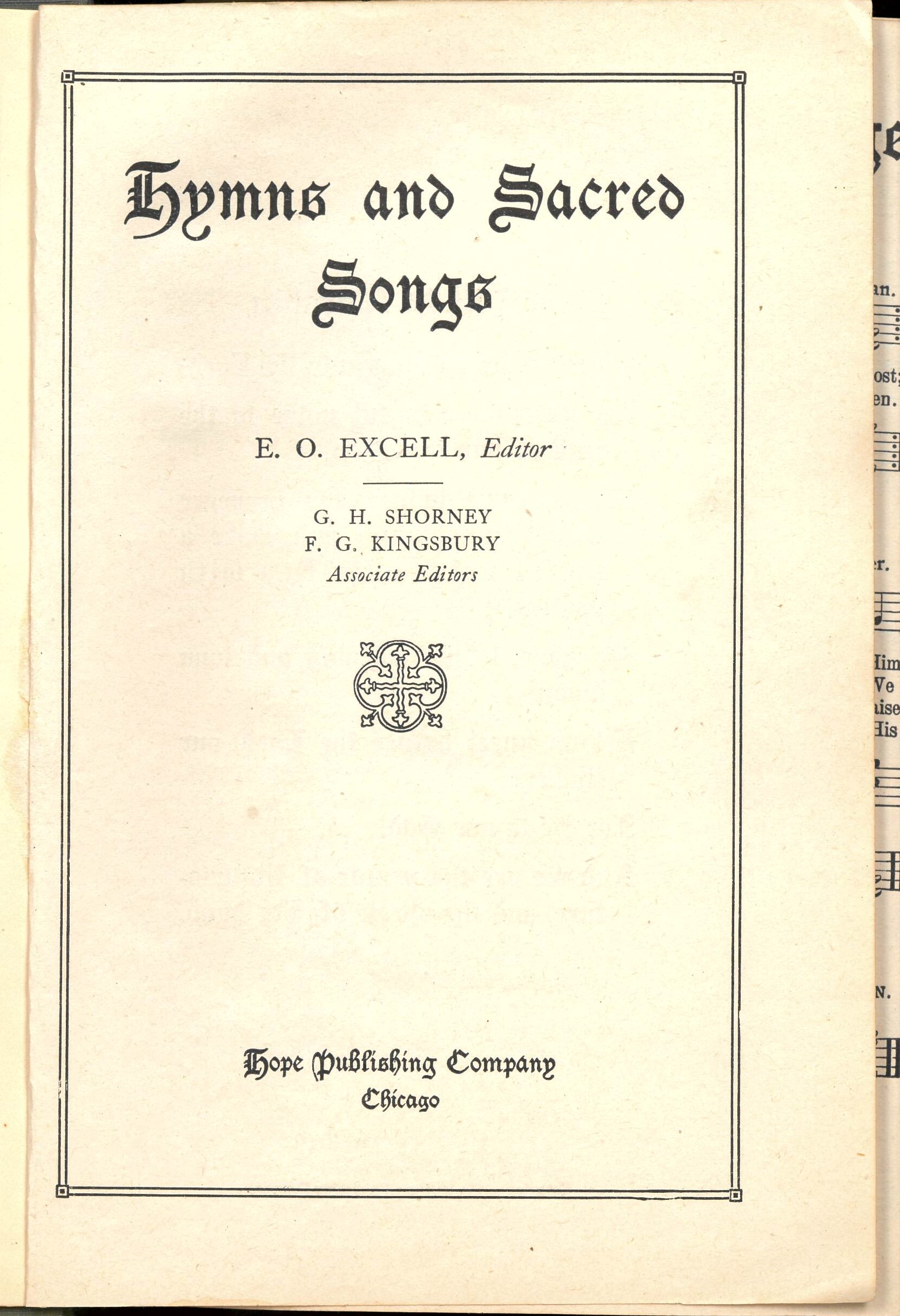
Hymns and Sacred Songs. E. O. Excell, Editor. Hope Publishing Company: Chicago,1918. Title page.
Notice the similarity in appearance between Excell’s book and the first printing of Great Songs, which was produced on Excell’s factory presses.
Alexander’s Gospel Songs. Charles M. Alexander, Compiler. Fleming H. Revell Company: New York, 1908.
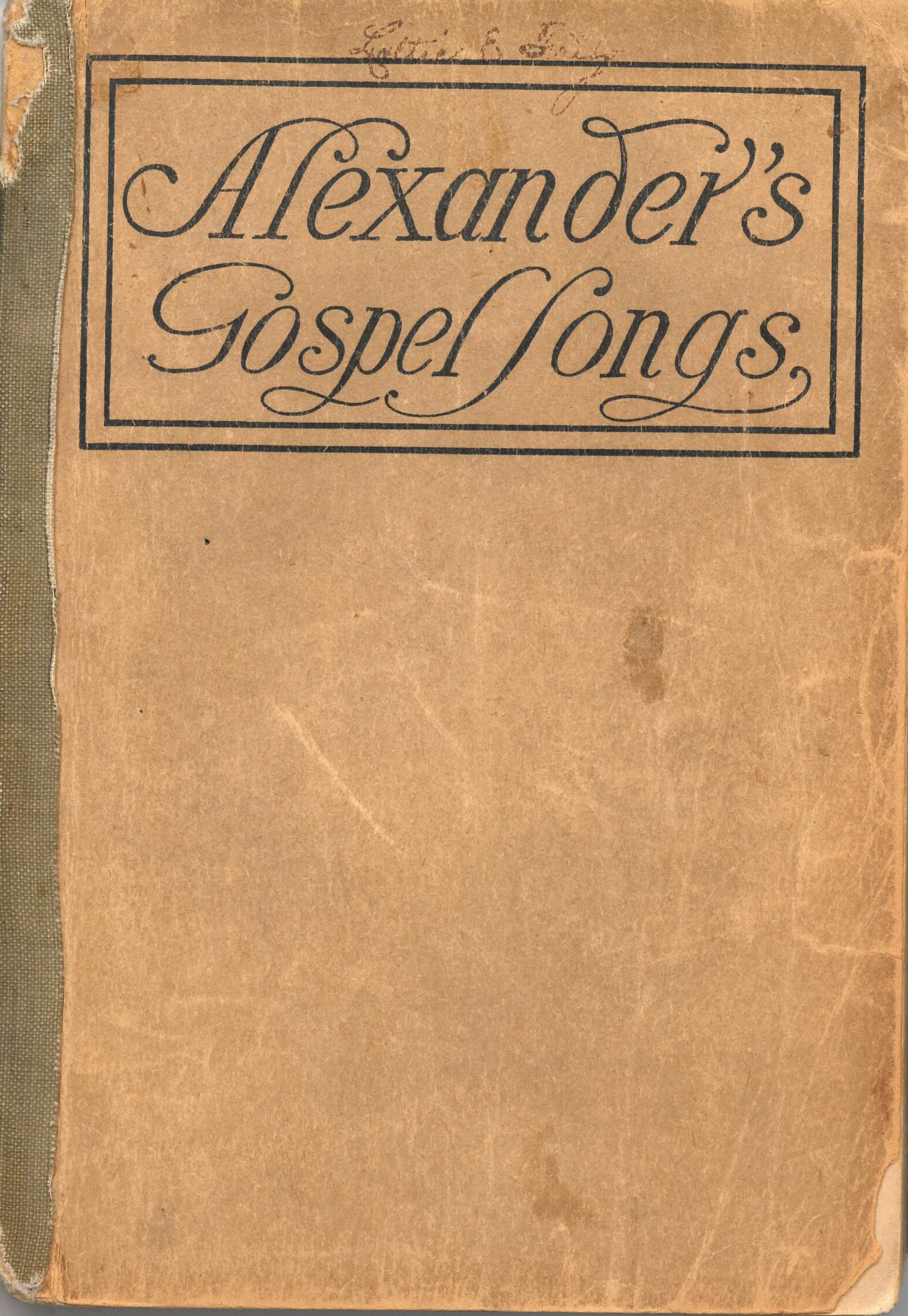
Alexander’s Gospel Songs. Charles M. Alexander, Compiler. Fleming H. Revell Company: New York, 1908. Front cover.

Alexander’s Gospel Songs. Charles M. Alexander, Compiler. Fleming H. Revell Company: New York, 1908. Title page.
Excell and Alexander side-by-side in Great Songs of the Church
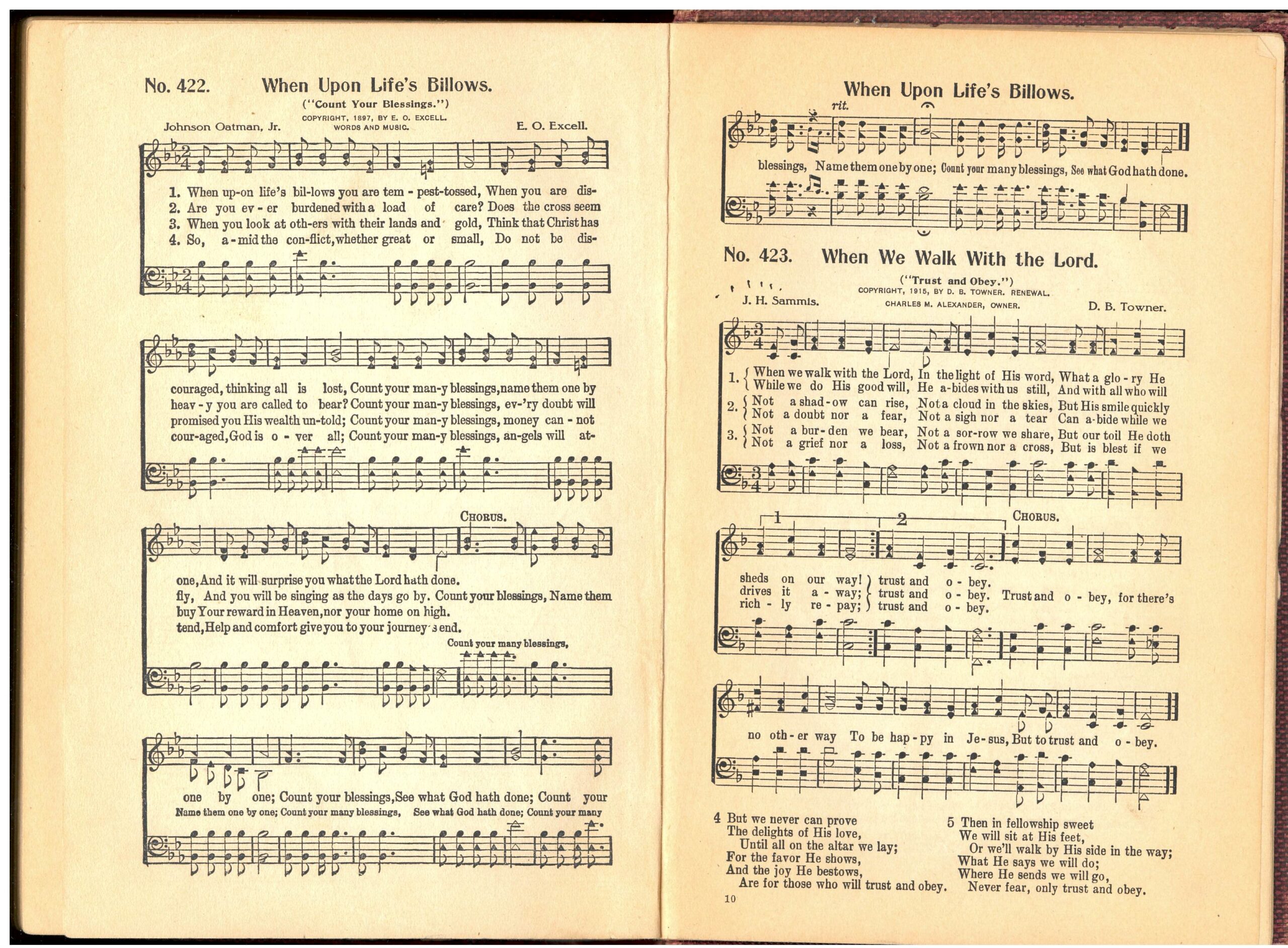
Excell and Alexander side-by-side in Great Songs of the Church
Advertisements and photographs:
These ads illustrate the rapid and sustained sale of Great Songs throughout the 1920s into the 1950s. In them Jorgenson routinely named the congregations and colleges which used his hymnal. The strategy encouraged wider use but drew the ire of his critics. By the late 1940’s many of the largest congregations, and all schools and colleges, among Churches of Christ used Great Songs. The photographs below show it in use at daily chapel at Harding College (Searcy, Arkansas) and Abilene Christian College.
‘Since last month…,’ Word and Work, back cover October 1933.

‘Since last month…,’ Word and Work, back cover October 1933.
‘What Some have Said…,’ Christian Leader, back cover, March 1, 1938.

‘What Some have Said…,’ Christian Leader, back cover, March 1, 1938.
‘In gratitude to God…,’ World Vision, back cover January-March 1944.
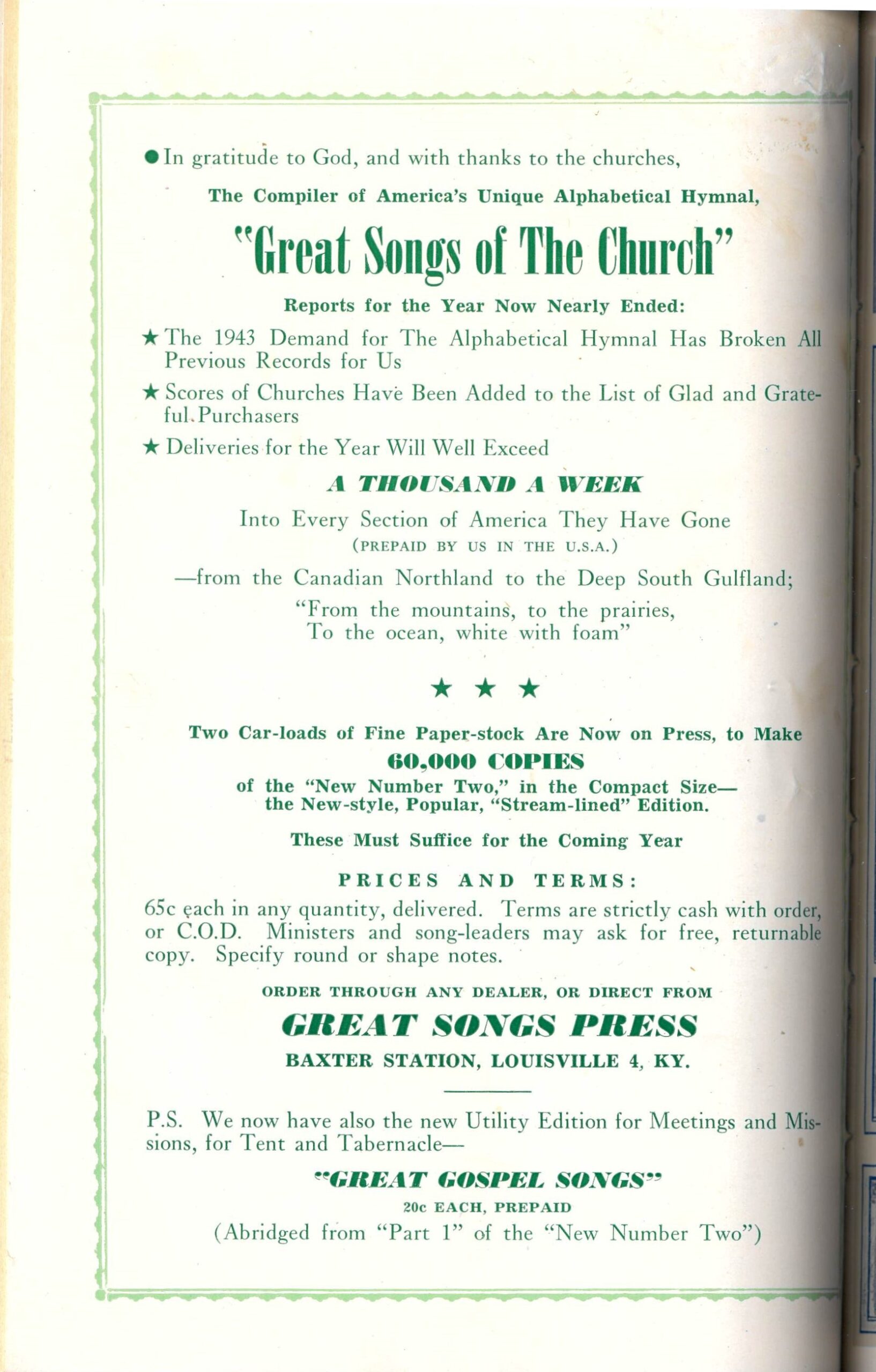
‘In gratitude to God…,’ World Vision, back cover January-March 1944.
‘At Harding We Sing,’ Twentieth Century Christian, undated special singing issue, ca. 1950.
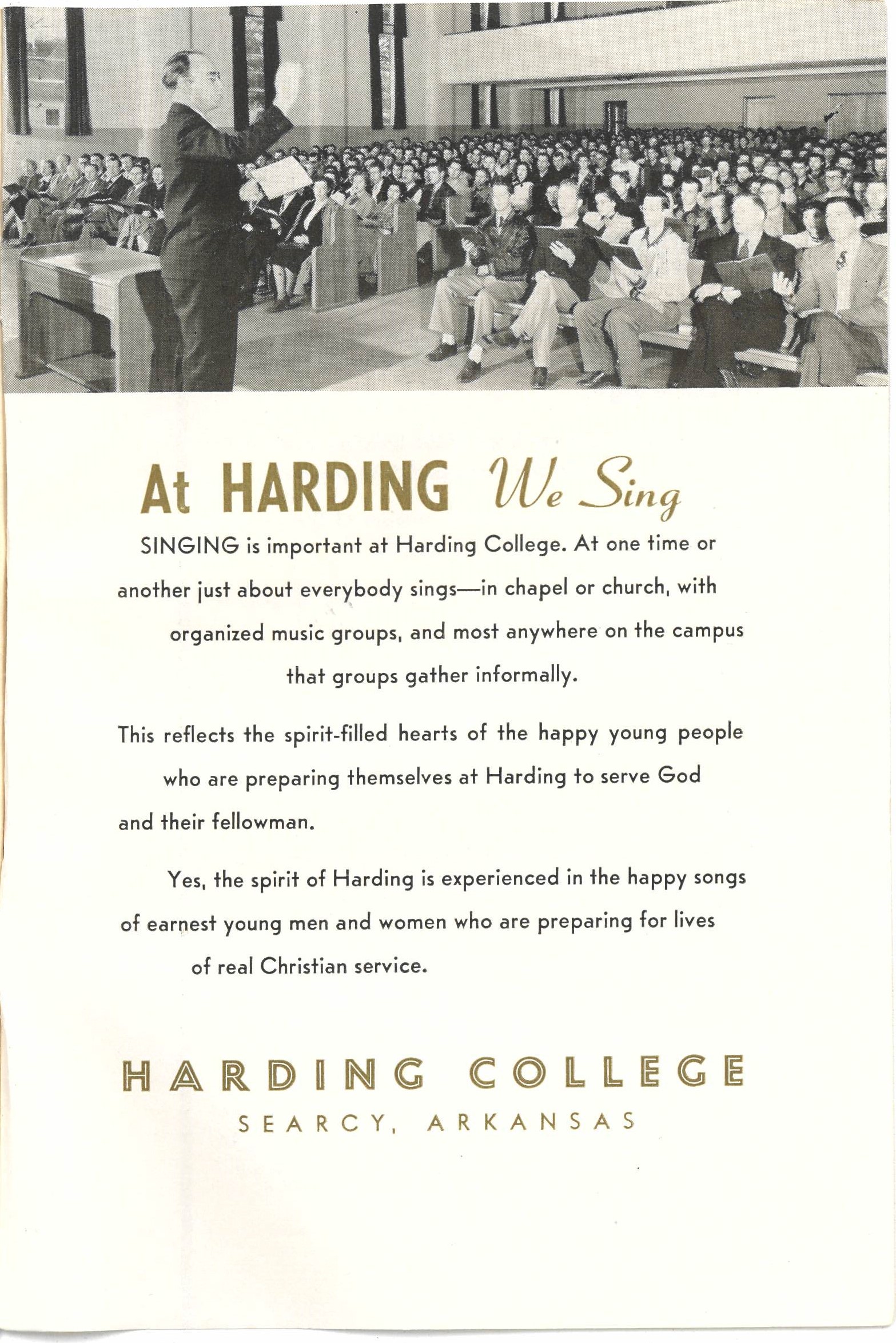
‘At Harding We Sing,’ Twentieth Century Christian, undated special singing issue, ca. 1950.
Photograph of daily chapel in Sewell Auditorium, Abilene Christian College, ca 1955.
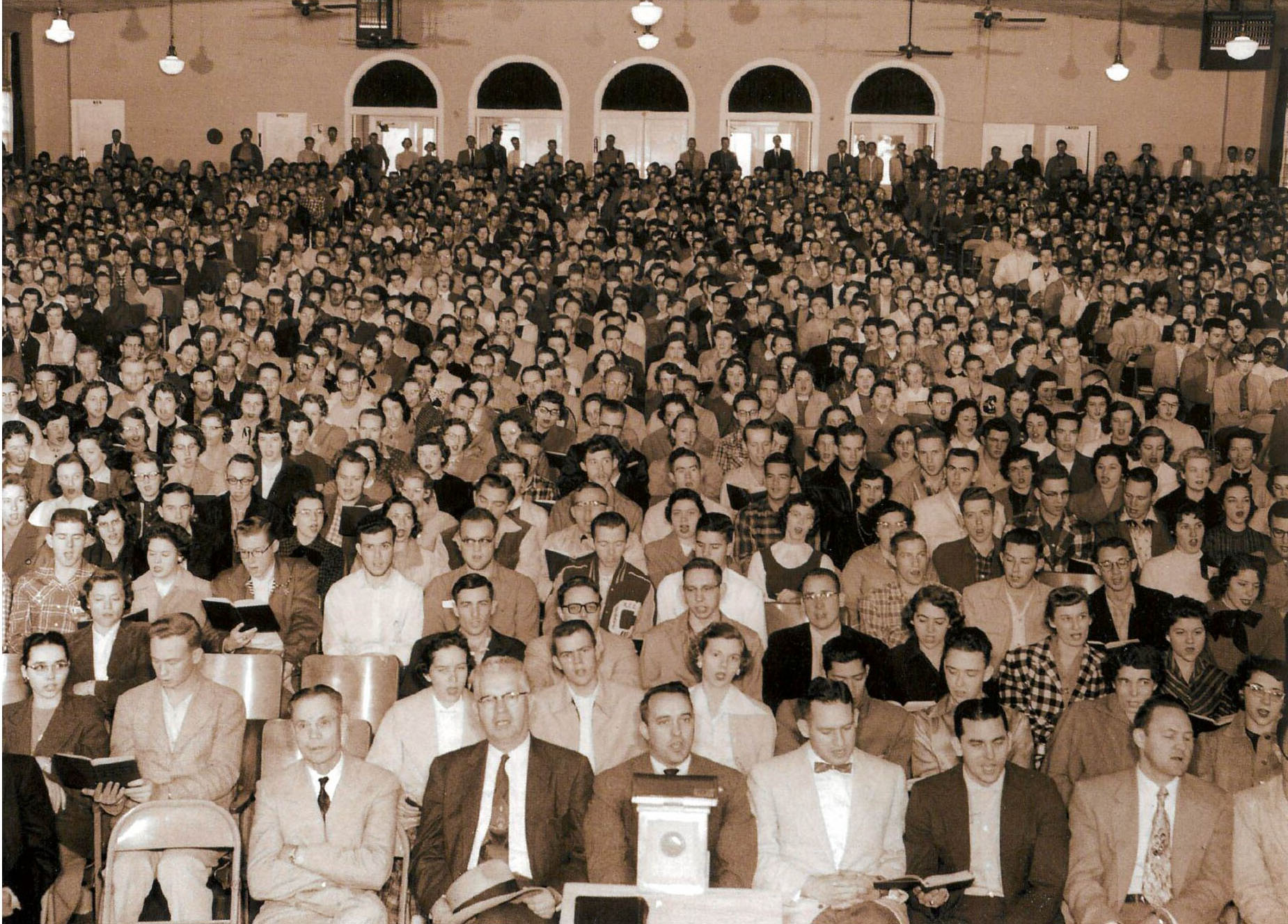
Photograph of daily chapel in Sewell Auditorium, Abilene Christian College, ca 1955.
Great Songs in the 1930s-1960s: Its Prominence Contested but its Circulation Enlarged
Jorgenson was an unashamed proponent of premillennialism. He believed the return of Jesus Christ would precede a literal thousand-year term of bliss and peace across the earth. He likely arrived at this conclusion through his association with R. H. Boll and others in Odessa, Missouri and Louisville, Kentucky. However, this view was not widely held and debates about the nature of prophecy, the book of Revelation, and the end-times raged hot and fierce among Churches of Christ from 1915 into the 1950s. By 1935 his association with Boll and the popularity of Great Songs combined to make him and the hymnal a target for critics. Churches of Christ had no central governing body which could adjudicate doctrinal disagreements about premillennialism, much less authorize or prohibit the use of a hymnal. Rather, consensus on these and other matters was achieved by persuasion through the church-related periodicals.
The Firm Foundation article below is one of the first such criticisms. Its author questioned the content of the hymnal and suggested its proceeds—which he claimed must surely be significant—funded R. H. Boll’s paper Word and Work thereby underwrote the promotion of premillennial doctrine. Years earlier Jorgenson anticipated such criticisms of a few of his selected hymns and removed them from the second edition in 1922 and the 1937 revision. He also responded to the charge that his publishing efforts even turned a profit, much less a substantial one. By means of publishing this certified audit he admitted Great Songs Press in fact turned a profit…a total of $9.38.
However, Wallace’s charge retained traction in some circles and proved to be an enduring criticism. In 1948 World Vision Publishing Company issued an edition without Jorgenson’s name on the title page to allow those who desired to distance themselves from him personally to still enjoy the benefits of the hymnal. As these ads demonstrate, when Jorgenson sold the rights to the shaped note edition to Christian Chronicle in 1953 (later acquired by Abilene Christian College Bookstore by 1957) it was heralded across the main stream of Churches of Christ as a significant coup against ‘the premillennials.’ Perhaps this is most clearly and succinctly articulated in the Gospel Guardian ad displayed below. Though his book remained unchanged, Jorgenson’s name was again dropped from the title page. Many congregations which formerly would not use it ordered hundreds of thousands of copies through its new publishers.
Foy E. Wallace, Jr. “Great Songs of the Church,” Firm Foundation, September 29, 1936.
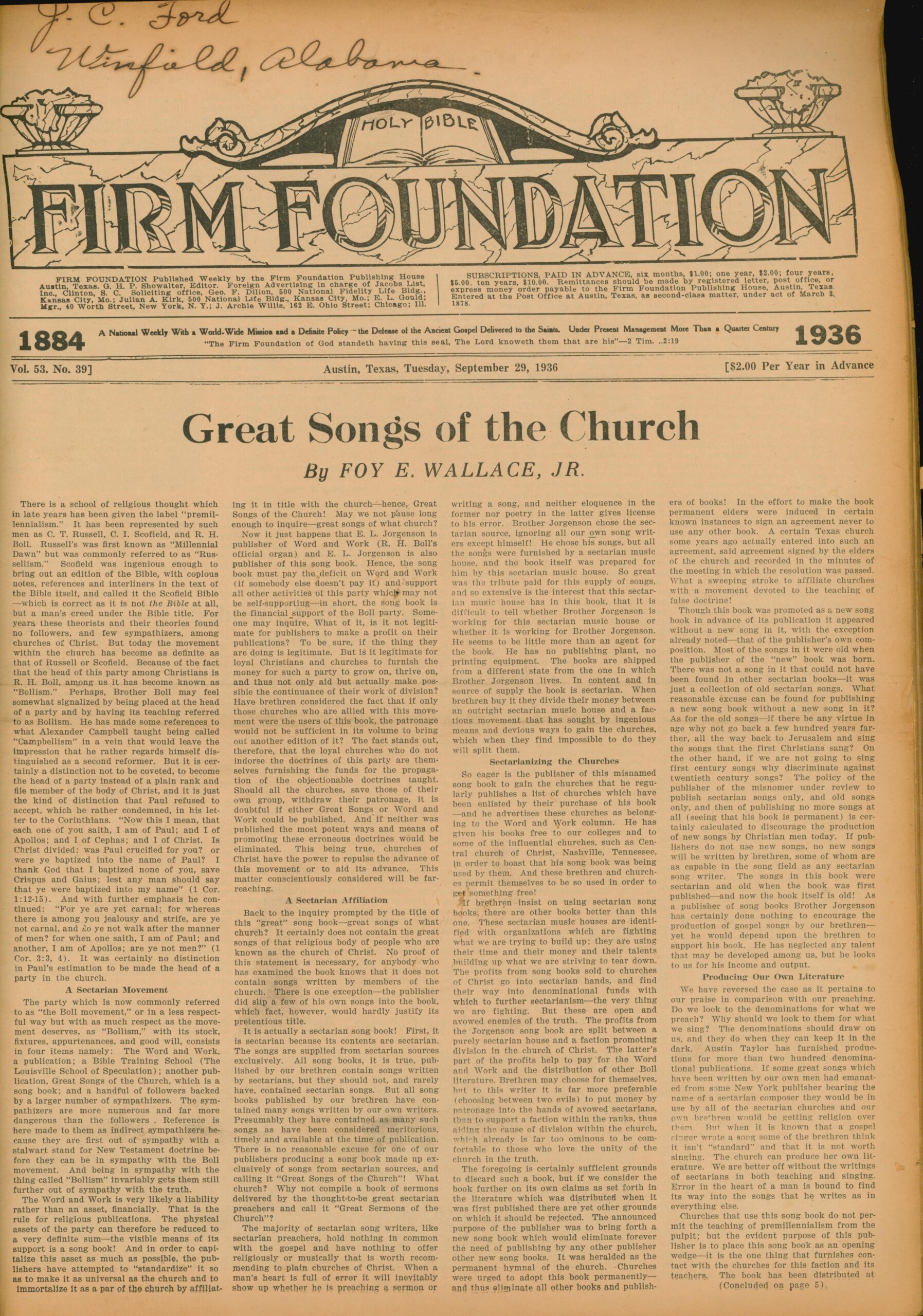
Foy E. Wallace, Jr. “Great Songs of the Church,” Firm Foundation, September 29, 1936.

Foy E. Wallace, Jr. “Great Songs of the Church,” Firm Foundation, September 29, 1936.
Advertisement, ‘Let’s Suppose…’ Christian Leader, December 15, 1939. Jorgenson utilized the rhetorical force of the recommendations of church leaders and publishers such as Marion Davis, N. B. Hardeman, G. A. Klingman, James L. Lovell, and B. K. Sommer to commend Great Songs.
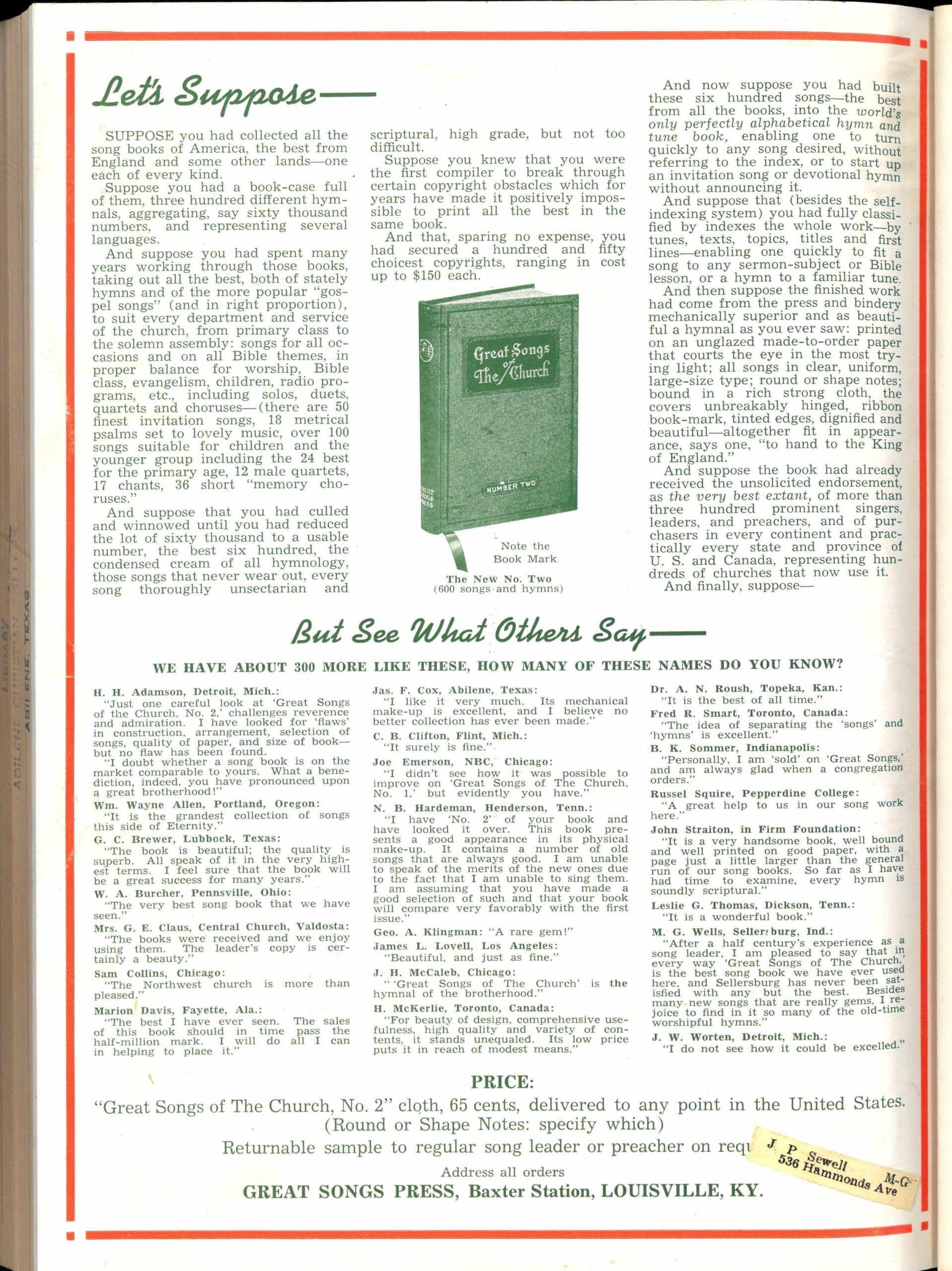
Advertisement, ‘Let’s Suppose…’ Christian Leader, December 15, 1939.
Advertisement, ‘Music Typography,’ Christian Leader March 1, 1940. In this ad Jorgenson details the laborious processes employed to produce a hymnal of the highest mechanical quality, which he sold basically at cost to ensure its widest possible use.

Advertisement, ‘Music Typography,’ Christian Leader March 1, 1940.
Advertisement, ‘Certified Audit,’ Christian Leader, May 15, 1940.

Advertisement, ‘Certified Audit,’ Christian Leader, May 15, 1940.
Advertisement, ‘An Old Story Never Told,’ Christian Leader, September 15, 1940.
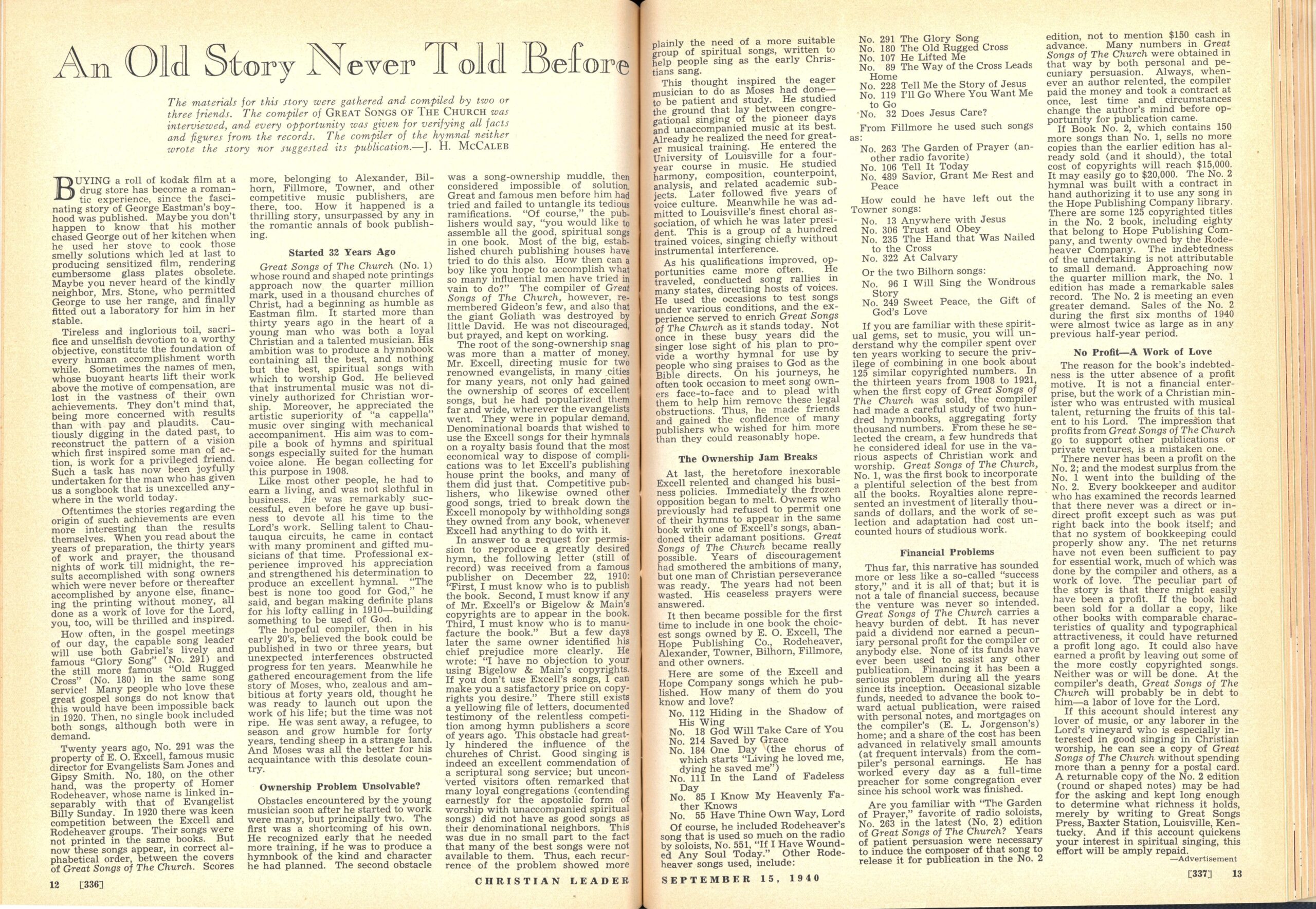
Advertisement, ‘An Old Story Never Told,’ Christian Leader, September 15, 1940.
Great Gospel Songs for Tent and Tabernacle. Great Songs Press: Louisville, 1943. This slim paperback of only gospel songs was for revivals, gospel meetings, and other occasions where the full (and heavier) hymnal was unneeded.
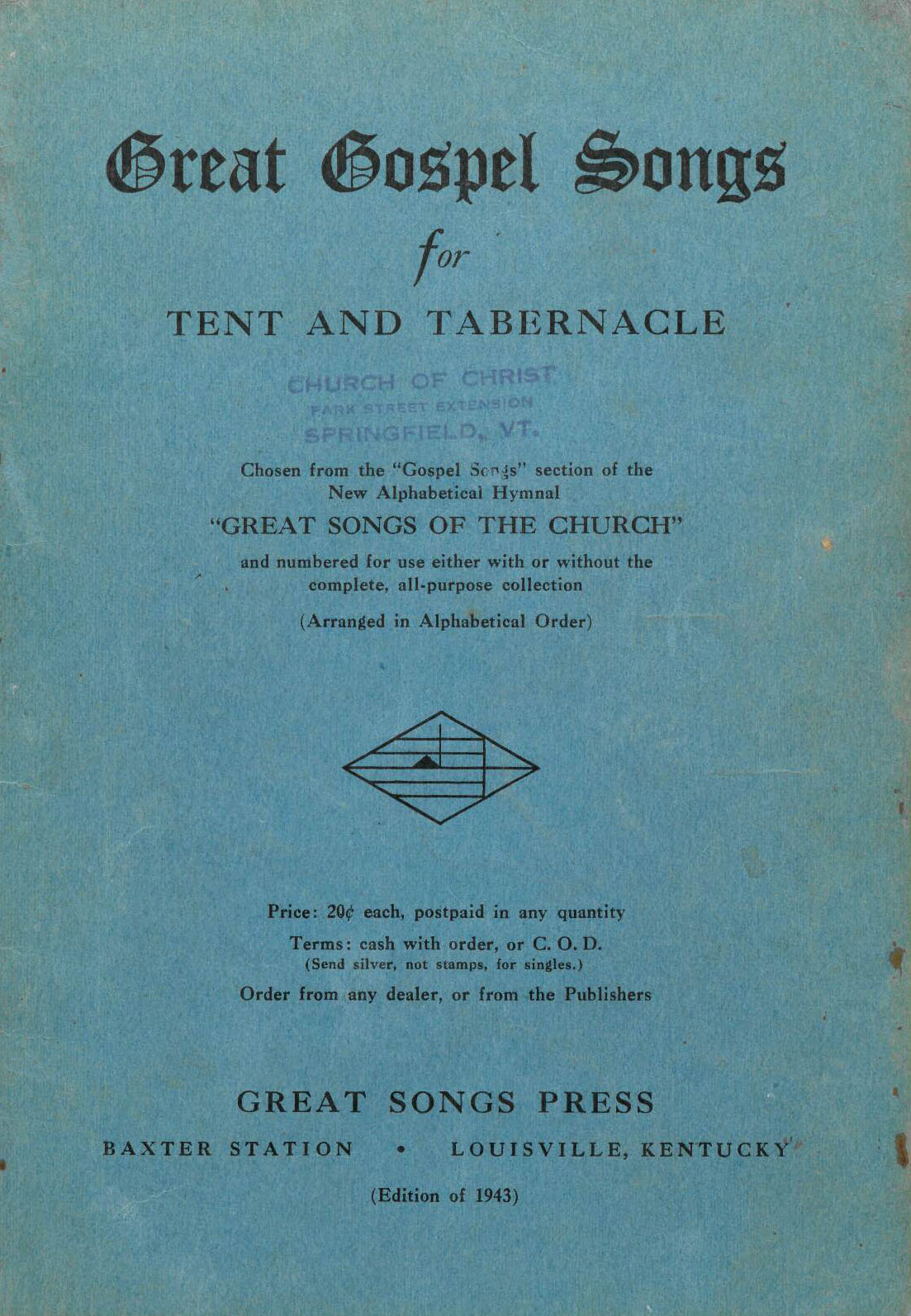
Great Gospel Songs for Tent and Tabernacle. Great Songs Press: Louisville, 1943. Front cover.
Great Songs of the Church, 28th edition, World Vision Publishing Company: Nashville, ca. 1948. The publisher marketed this as the ‘Nashville Edition’ to appeal to congregations in the Middle Tennessee area, where Boll and Jorgenson had many friends but many more critics.
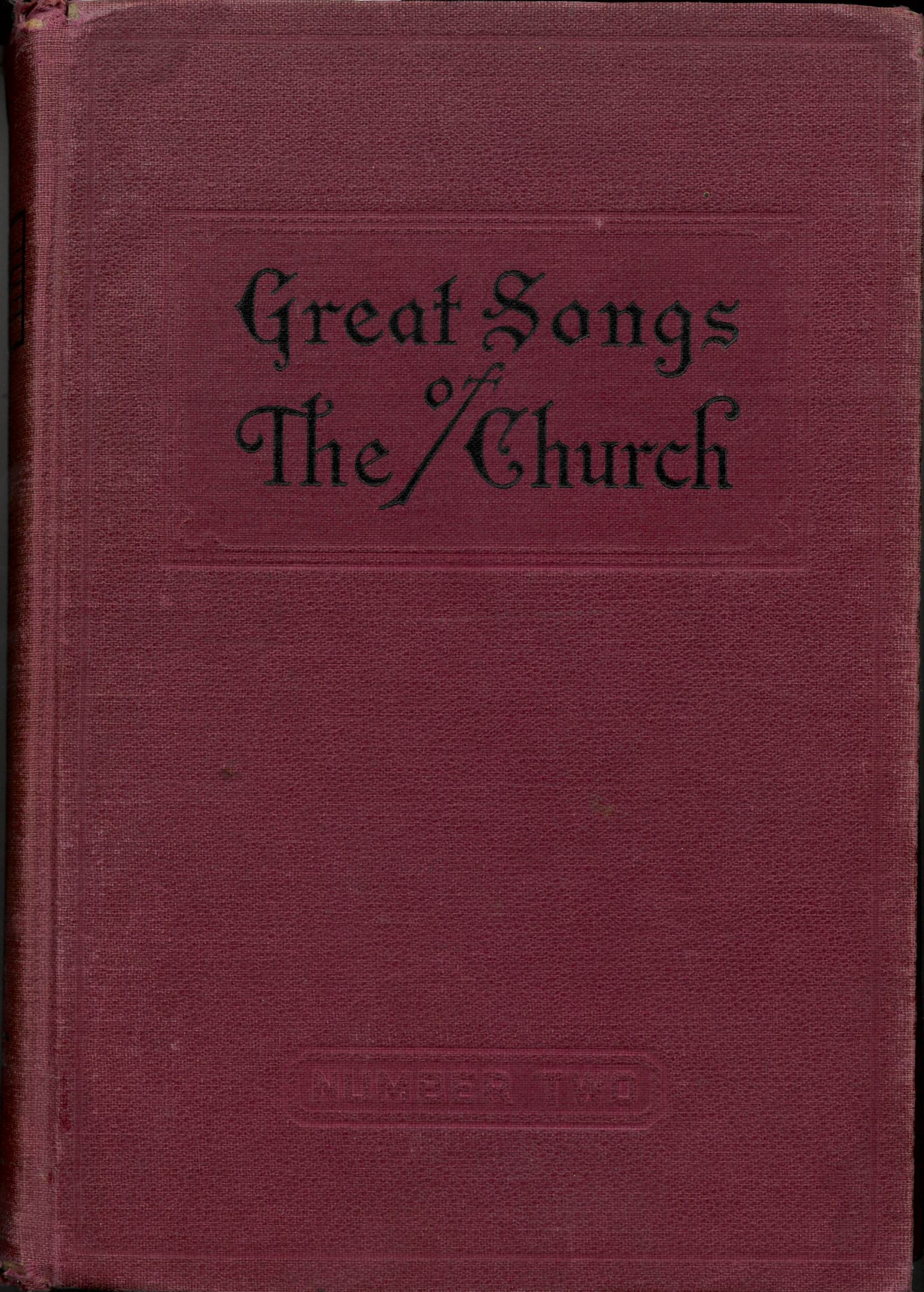
Great Songs of the Church, 28th edition, World Vision Publishing Company: Nashville, ca. 1948. Front cover.

Great Songs of the Church, 28th edition, World Vision Publishing Company: Nashville, ca. 1948. Title page.
‘Chronicle Buys Plates, Publications Rights of ‘Great Songs,’ Christian Chronicle October 7, 1953.

‘Chronicle Buys Plates, Publications Rights of ‘Great Songs,’ Christian Chronicle October 7, 1953.
Advertisement, ‘The Most Widely Accepted Hymnal in the Church,’ Christian Chronicle, June 23, 1954.
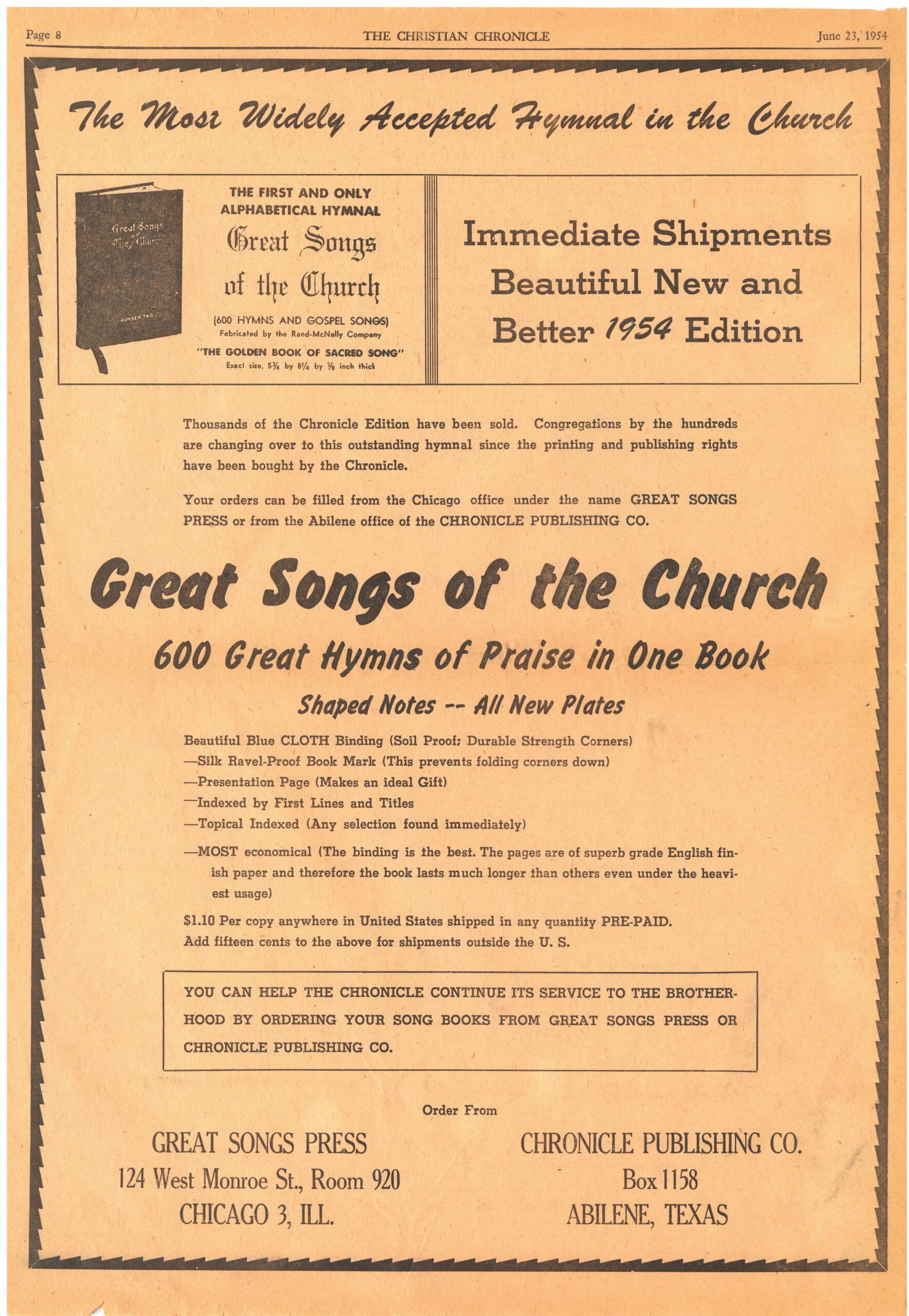
Advertisement, ‘The Most Widely Accepted Hymnal in the Church,’ Christian Chronicle, June 23, 1954.
Advertisement, ‘At Last,’ Gospel Guardian, February 7, 1957.
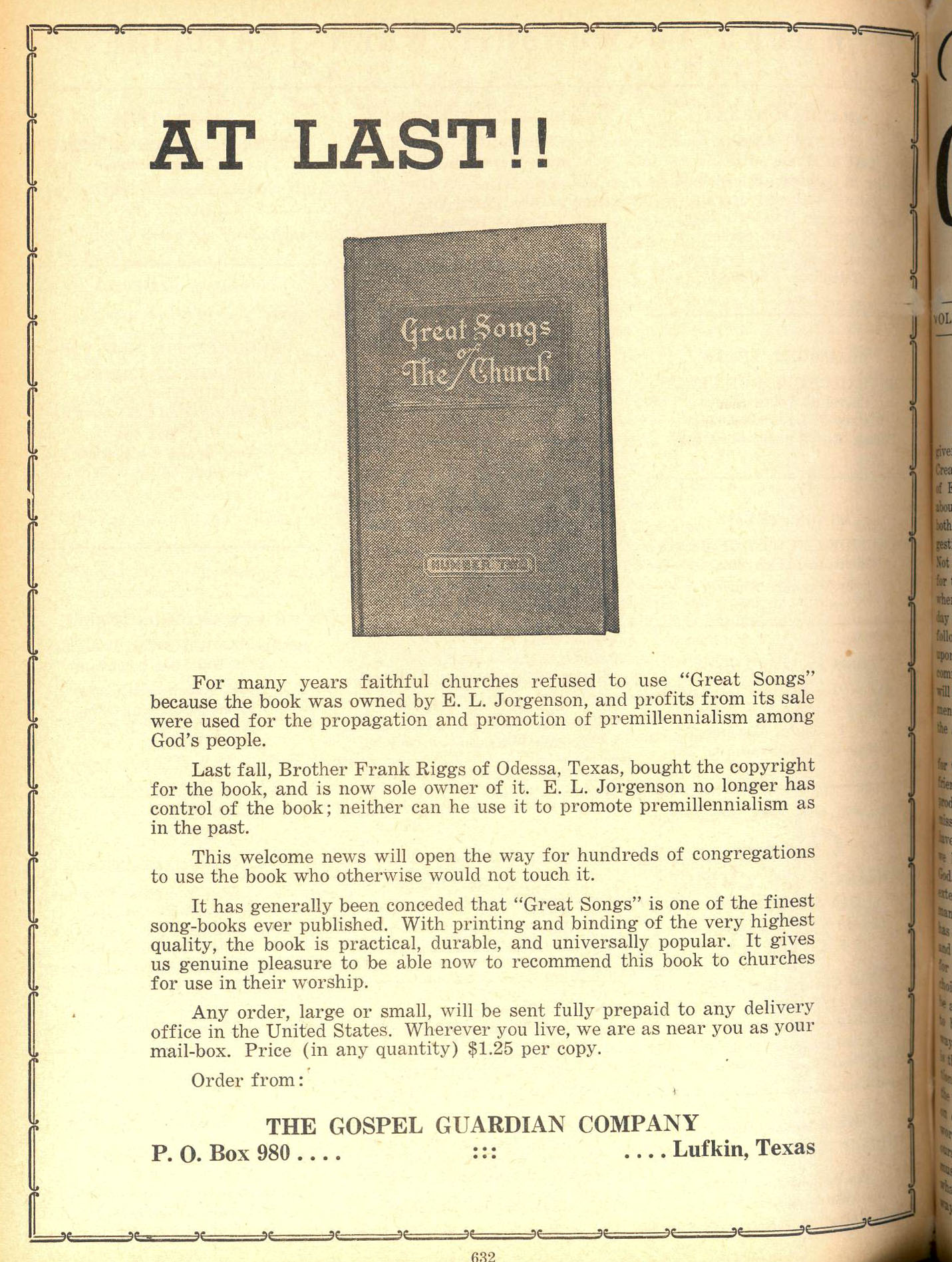
Advertisement, ‘At Last,’ Gospel Guardian, February 7, 1957.
Great Songs in the 1970s-1990s: Twilight Years of the Pace-Setting Hymnal
Jorgenson was largely successful in what he attempted: a single book that joined the long tradition of the richest hymns to the best of the newer popular gospel songs, and which was used by a significant cross-section of Churches of Christ. That it endured in print for nearly seventy years—longer than Alexander Campbell’s hymnal—is itself remarkable. Later hymnals not only adopted Jorgenson’s approach and mirrored his selections, but in some cases actually copied pages from his book. Through the body of songs he assembled, the arrangements of them he produced, and the sheer volume of use of his hymnal, Elmer Leon Jorgenson left an indelible mark on hymnody among Churches of Christ in the twentieth century.
The acquisition of the shaped-note edition by Abilene Christian College possibly gained for Great Songs a wider and longer exposure than it might have otherwise enjoyed. Displayed here are artifacts and promotional materials from the decades when ACU published Great Songs. To address the changing landscape of hymnody in the postwar decades, the university issued a supplement in 1974 (with accompanying LP albums) then a wholesale revision in 1986. In 1997 ACU English Professor Forrest McCann completed his magnum opus which details the remarkable story of Jorgenson’s hymnal and the selections it contains. It is displayed here with Great Songs of the Church, Revised in a boxed-set edition in the ACU President’s Circle Books series.
Printing block used for advertisements for Great Songs of the Church, ca. 1950s-1970s.
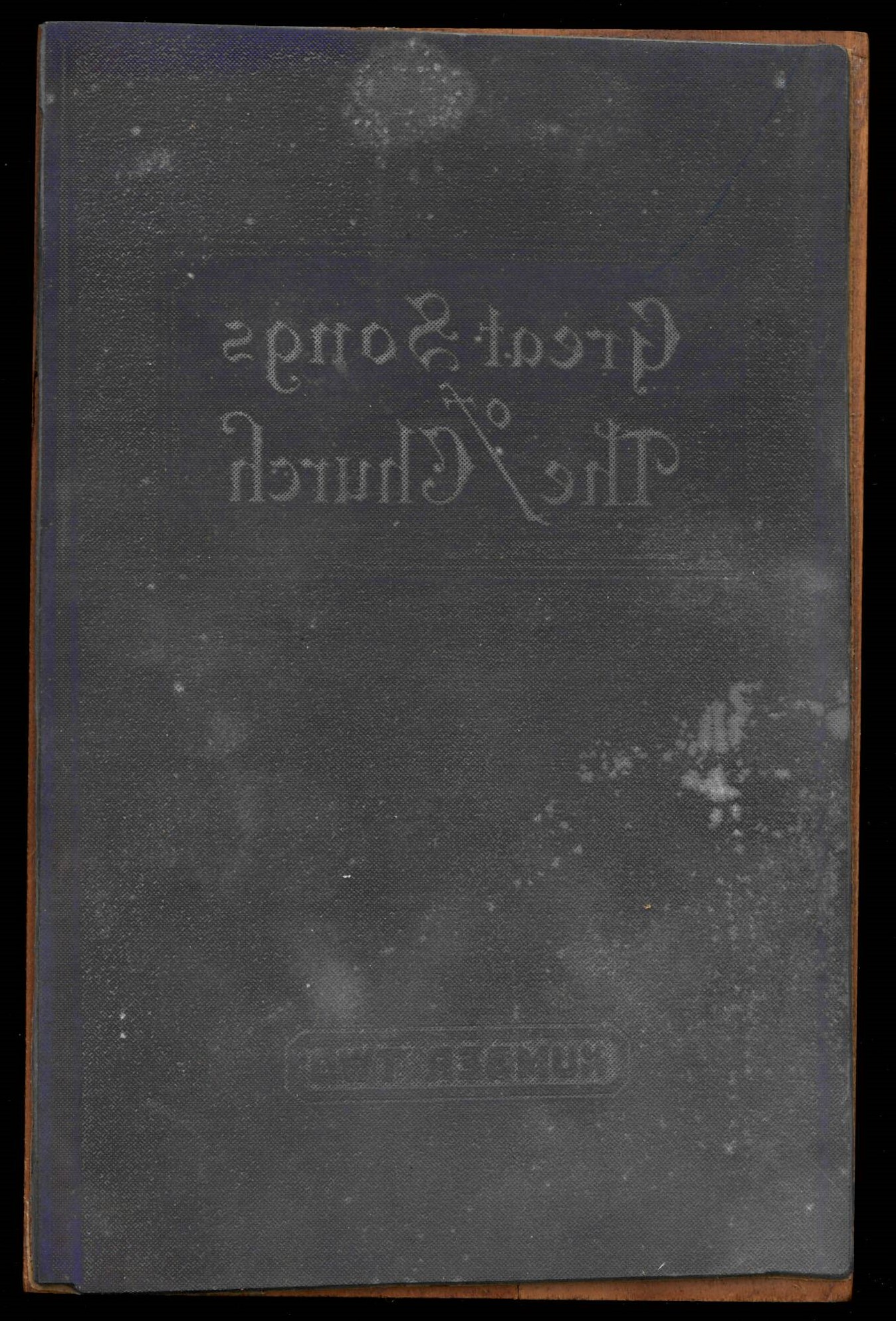
Printing block used for advertisements for Great Songs of the Church, ca. 1950s-1970s.
Advertisement for Great Songs of the Church using the printing block above. Christian Chronicle, September 17, 1957.
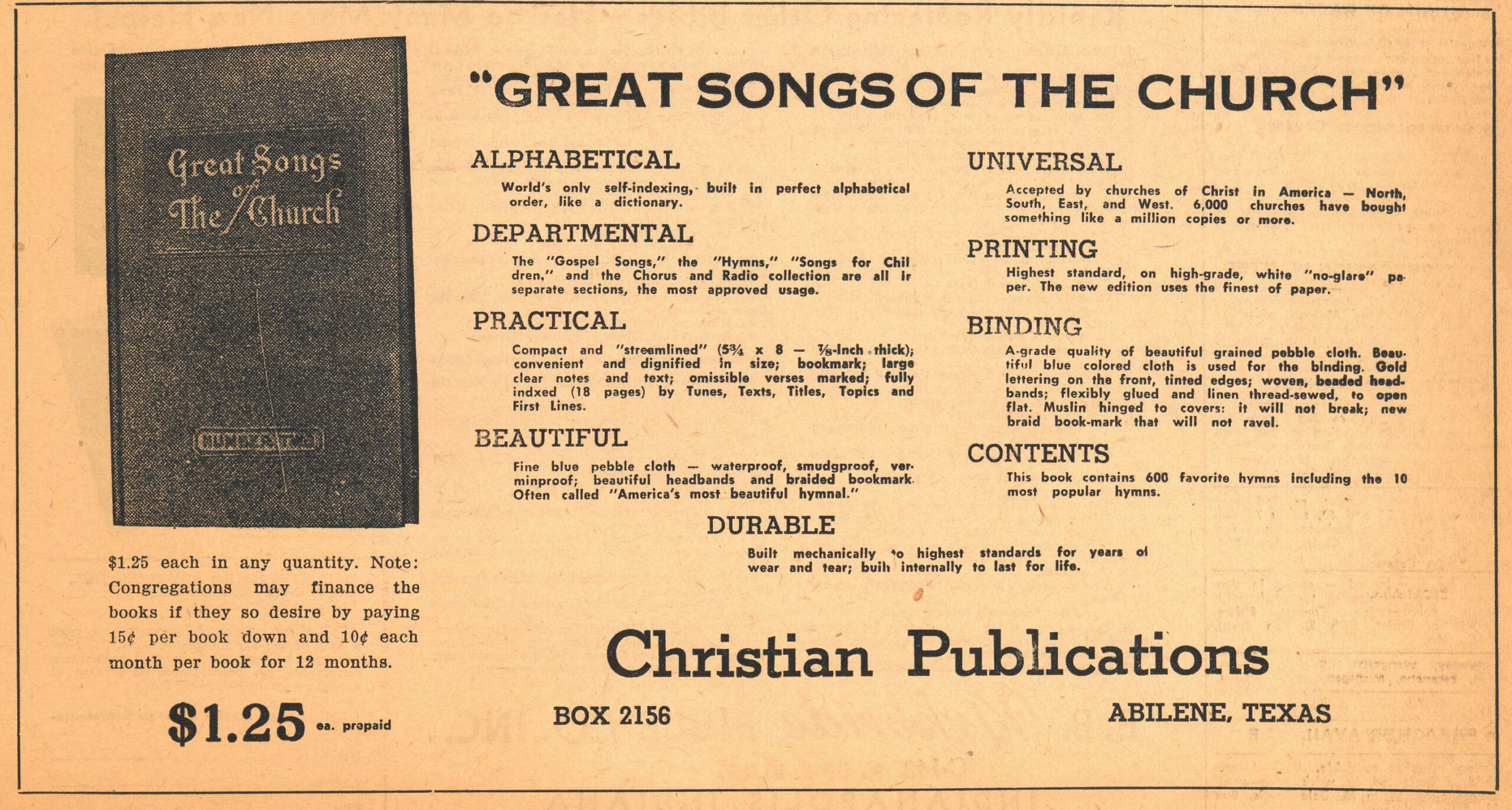
Advertisement for Great Songs of the Church using the printing block above. Christian Chronicle, September 17, 1957.
Great Songs of the Church, 50th Anniversary Edition. This deluxe blue leather edition was printed in 1971.

Great Songs of the Church, 50th Anniversary Edition.
Supplement to Great Songs of the Church, Alphabetically Arranged. Great Songs Press [Abilene, Texas], 1974. Front cover.
![Supplement to Great Songs of the Church, Alphabetically Arranged. Great Songs Press [Abilene, Texas], 1974. Front cover.](https://blogs.acu.edu/specialcollections/files/2021/09/ACU_Exhibit_2021GreatSongs_Case4_SupplementInGreatSongsOfTheChurch_1975__1-2.jpg)
Supplement to Great Songs of the Church, Alphabetically Arranged. Great Songs Press [Abilene, Texas], 1974. Front cover.
Choralaires LP Album
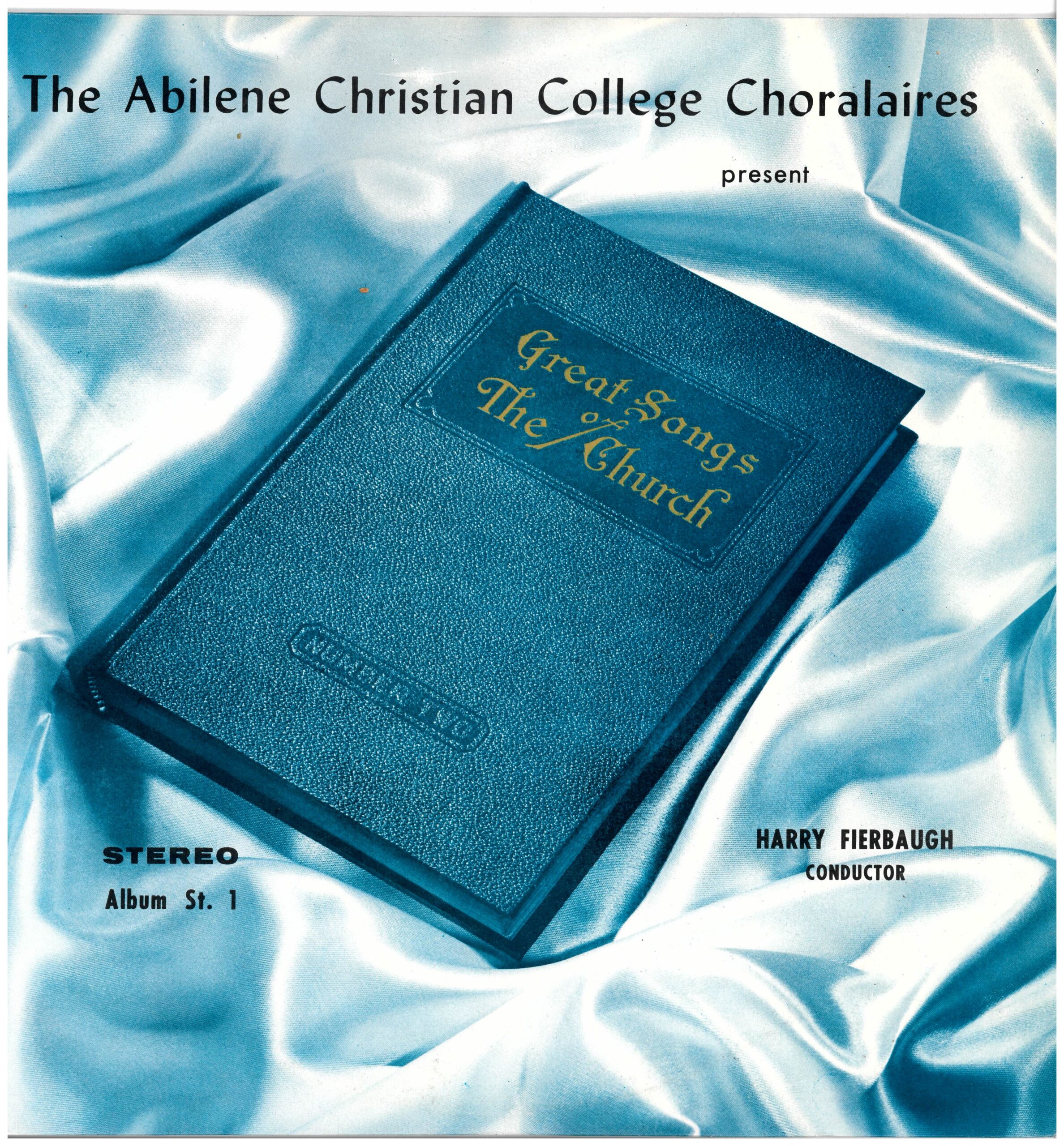
Choralaires LP album cover
Supplement to Great Songs of the Church LP album

Supplement to Great Songs of the Church LP album cover
Forrest M. McCann, Hymns and History: An Annotated Survey of Sources. ACU Press: Abilene, 1997. ACU Presidents’ Circle Edition with Great Songs of the Church, Revised.

Forrest M. McCann, Hymns and History: An Annotated Survey of Sources. ACU Press: Abilene, 1997. ACU Presidents’ Circle Edition with Great Songs of the Church, Revised.
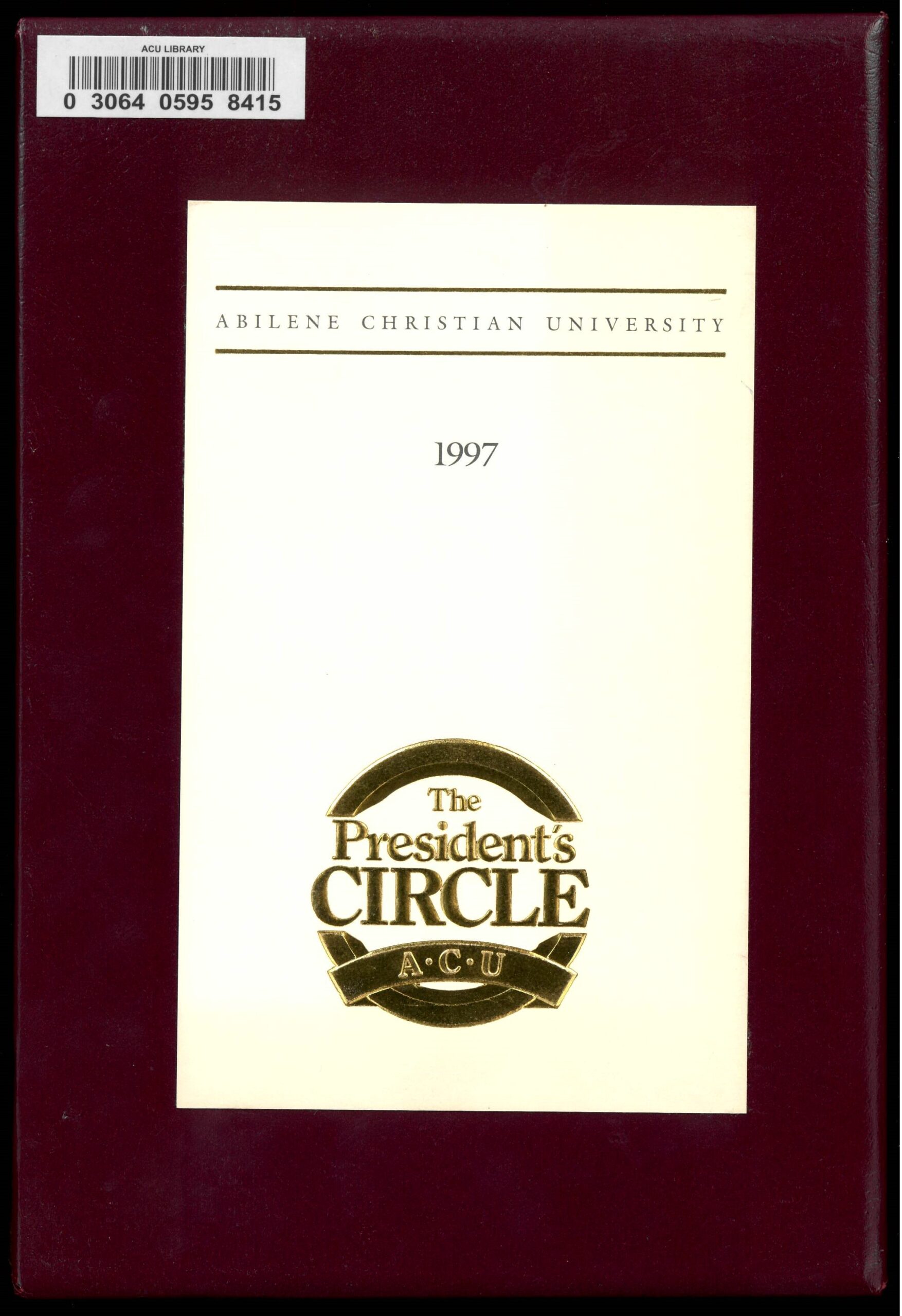
Forrest M. McCann, Hymns and History: An Annotated Survey of Sources. ACU Press: Abilene, 1997. ACU Presidents’ Circle Edition with Great Songs of the Church, Revised.
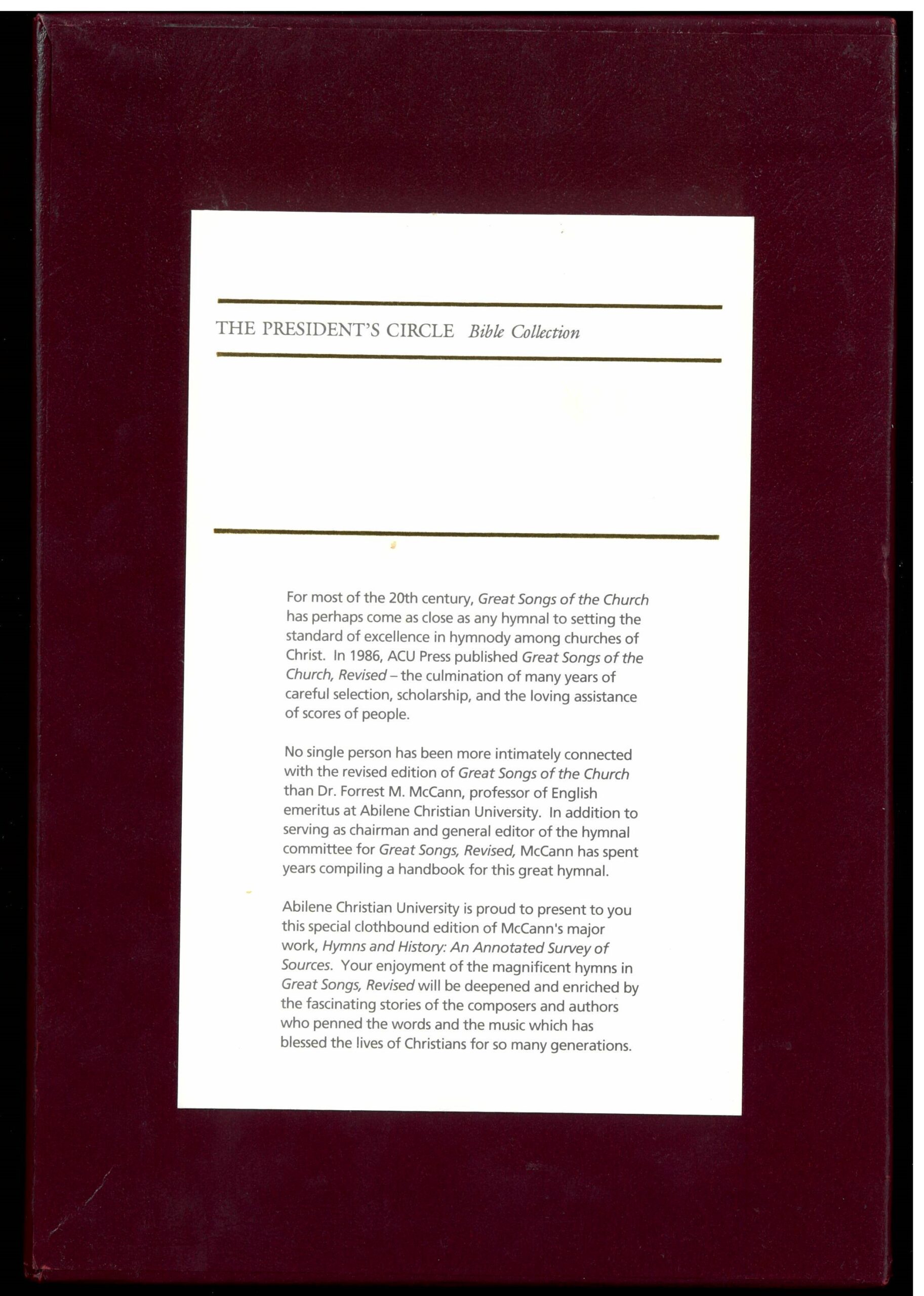
Forrest M. McCann, Hymns and History: An Annotated Survey of Sources. ACU Press: Abilene, 1997. ACU Presidents’ Circle Edition with Great Songs of the Church, Revised.
Great Songs of the Church Centennial Celebration Edition, 1921-2021. This paperback was produced for use at special sessions at Christian Scholars Conference, Nashville, TN in June and at Restoration Day, Abilene, September, 2021.

Great Songs of the Church Centennial Celebration Edition, 1921-2021.
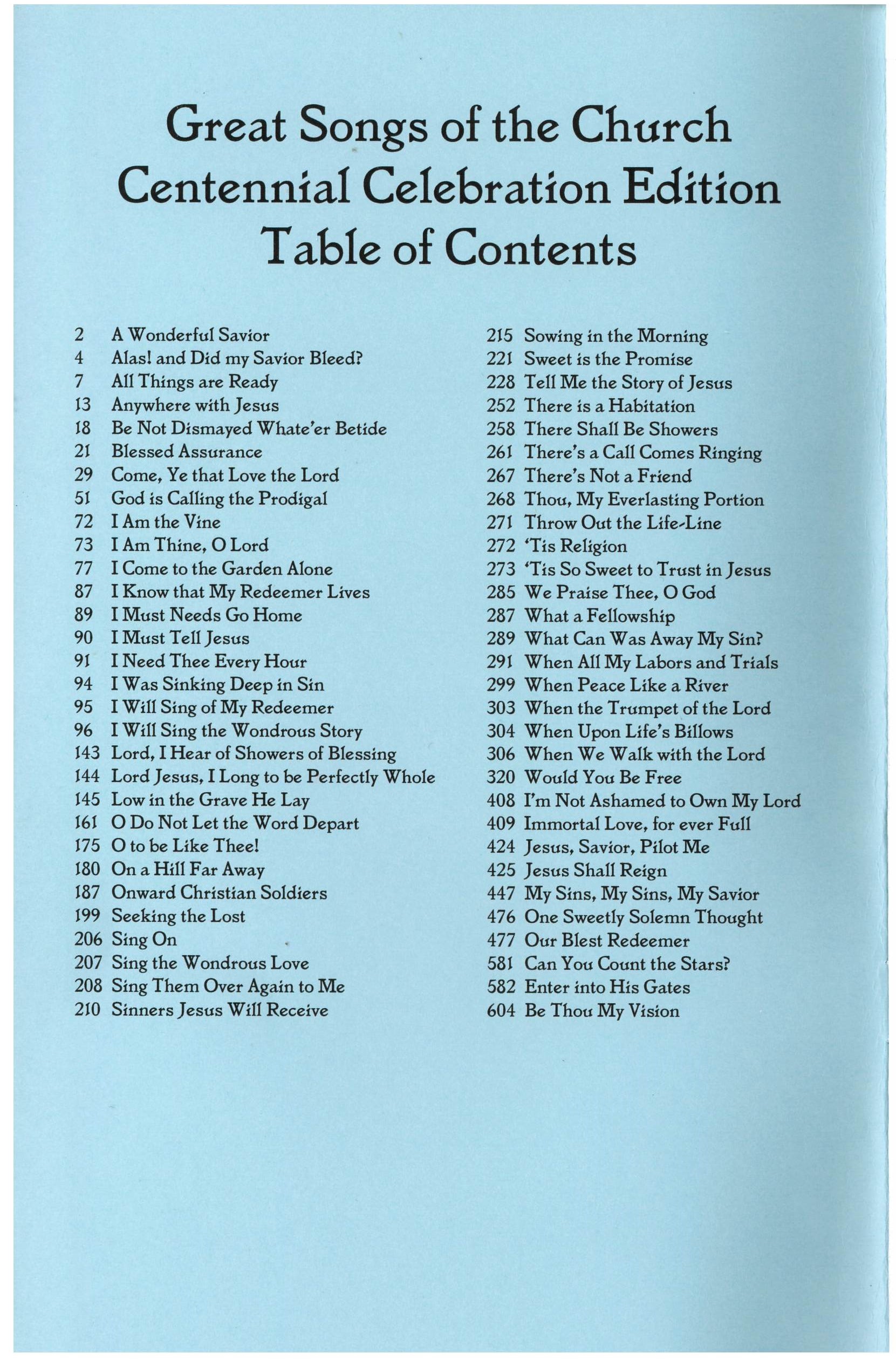
Great Songs of the Church Centennial Celebration Edition, 1921-2021.
For further study:
Links below should open in a new tab.
Great Songs of the Church: A Comprehensive Collection of Psalms, Hymns, and Spiritual Songs of the First Class, Suitable for all Services of the Church, Alphabetically Arranged. E. L. Jorgenson, Compiler. First Edition. Word and Work: Louisville, 1921. Available at: https://archive.org/details/greatsonchur00jorg/mode/2up and the list of texts and tunes available at: https://hymnary.org/hymnal/GSoC1921
Great Songs of the Church: A Comprehensive Collection of Psalms, Hymns, and Spiritual Songs of the First Class, Suitable for all Services of the Church, Alphabetically Arranged. E. L. Jorgenson, Compiler. Second Edition. Word and Work: Louisville, 1926. Available at: https://digitalcommons.acu.edu/crs_books/194/ and the list of texts and tunes from the 1935 printing available at: https://hymnary.org/hymnal/GSoC1935
The New Alphabetical Hymnal. Great Songs of the Church Number Two. A Treasury of Six Hundred Sacred Songs Suitable for All Services of the Church. E. L. Jorgenson, Compiler. Great Songs Press: Louisville, 1937. 39th printing, 1961. Available at: https://archive.org/details/newalphabeticalh00jorg/mode/2up and the list of texts and tunes available at: https://hymnary.org/hymnal/GSC1937
Great Gospel Songs for Tent and Tabernacle. Great Songs Press: Louisville, 1943. Available at: https://digitalcommons.acu.edu/crs_books/316/
Forrest M. McCann, Hymns and History: An Annotated Survey of Sources. ACU Press: Abilene, 1997.
Forrest M. McCann, “E. L. Jorgenson and the Longest-Lived Hymnal in the Stone-Campbell Movement” 1997 Abilene Christian University Lectureship. Available at: https://digitalcommons.acu.edu/sumlec_audio/2891/
Forrest M. McCann, “Hymnbooks on purpose—Hymnody in the Stone-Campbell Movement” 1985 Abilene Christian University Lectureship. Available at: https://digitalcommons.acu.edu/sumlec_audio/4802/
Gary McCaleb and Forrest M. McCann, “On Campus Video featuring Dr. Forrest McCann, October 2, 1984”. Available at: https://digitalcommons.acu.edu/on_campus/180/
Dale A. Jorgenson, “Great Songs of the Church, The Story of a Hymnal,” Restoration Quarterly 56:3, Third Quarter 2014.
John Conrad Wakefield, “The Influence of the Hymnal ‘Great Songs of the Church’ in Christian Churches,” A Paper Presented at the Stone-Campbell Journal Conference and Christian Scholars Conference, 2021. Available at: http://www.stone-campbelljournal.com/fileadmin/pdfs/conference/2021/wakefield.pdf
Jim Mankin and Jason Fikes, “When Shall I Reach That Happy Place?” Apocalyptic Themes in the Hymns of the Stone-Campbell Movement,” Restoration Quarterly 38:1, First Quarter 1996. Available at: https://digitalcommons.acu.edu/restorationquarterly/vol38/iss1/4/
Dale Jorgenson, “E. L. Jorgenson: A Song of Christian Love,” Word and Work, August 1995. Available at: http://www.wordandwork.org/2016/05/e-l-jorgenson-a-song-of-christian-love/?fbclid=IwAR3uUTiSMEnv8nUCOmz9HpeTDCDs9WPFz9YWibsMnMILcJ2QzsK9Y6alVD4
Forrest M. McCann, “Fifty Years of Song,” Word and Work, June 1971. Available at: https://www.therestorationmovement.com/_journals/ww/1971/1971-06-WW.pdf
Jack Boyd, “Old Hymns and Other Exposed Nerves, The Perils of Re-editing ‘Old Blue’” and Reid Lancaster, Review of Great Songs of the Church, Revised, Mission Journal, May 1987. Available at: https://digitalcommons.acu.edu/missionjournal/vol20/iss11/1/
Supplement to Great Songs of the Church, 1975, four LP albums available in nine parts:
Part 1: https://digitalcommons.acu.edu/crs_audio_video/73/
Part 2: https://digitalcommons.acu.edu/crs_audio_video/74/
Part 3: https://digitalcommons.acu.edu/crs_audio_video/77/
Part 4: https://digitalcommons.acu.edu/crs_audio_video/76/
Part 5: https://digitalcommons.acu.edu/crs_audio_video/75/
Part 6: https://digitalcommons.acu.edu/crs_audio_video/81/
Part 7: https://digitalcommons.acu.edu/crs_audio_video/79/
Part 8: https://digitalcommons.acu.edu/crs_audio_video/78/
Part 9: Jack Boyd, ‘Teaching New Hymns to the Congregation’: https://digitalcommons.acu.edu/crs_audio_video/5/
Sewell chapel singing and scripture service, 1966. https://digitalcommons.acu.edu/historical_audio_video/16/
Joey Roberts, “Centennial celebration: ‘Great Songs of the Church’ marks 100 years of influence,” Christian Chronicle online edition available at: https://christianchronicle.org/centennial-celebration-great-songs-of-the-church-marks-100-years-of-influence/
——-
This analog exhibit was curated by Mac Ice and was opened for display in the ACU Library September 2021-present. This digital exhibit was prepared by Mac Ice, September 20, 2021.
To see more exhibits from ACU Special Collections and Archives please visit our exhibit page.
